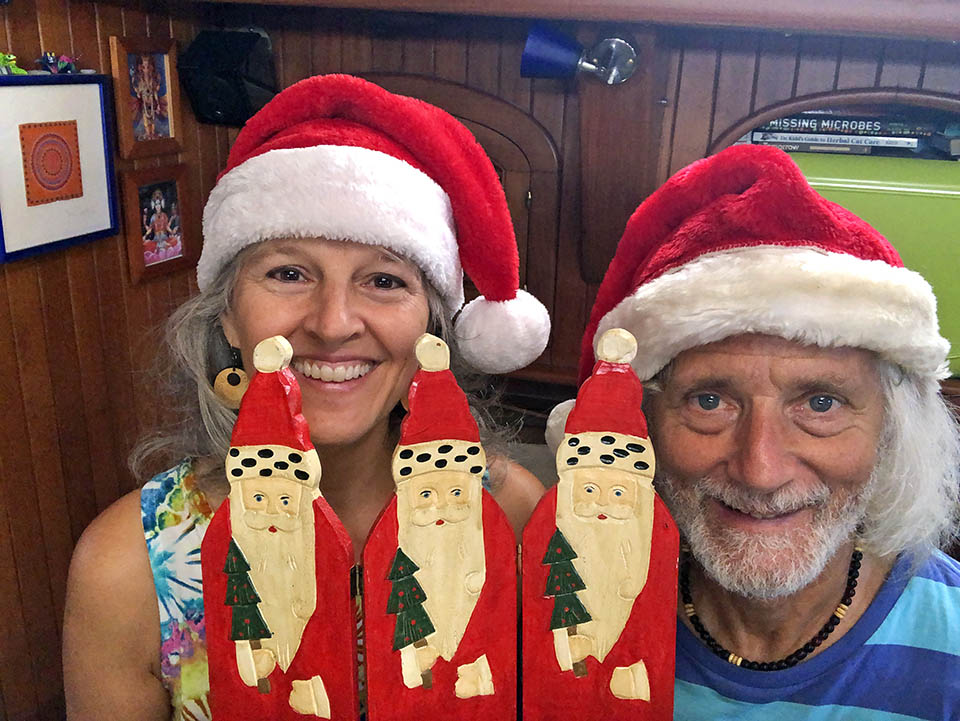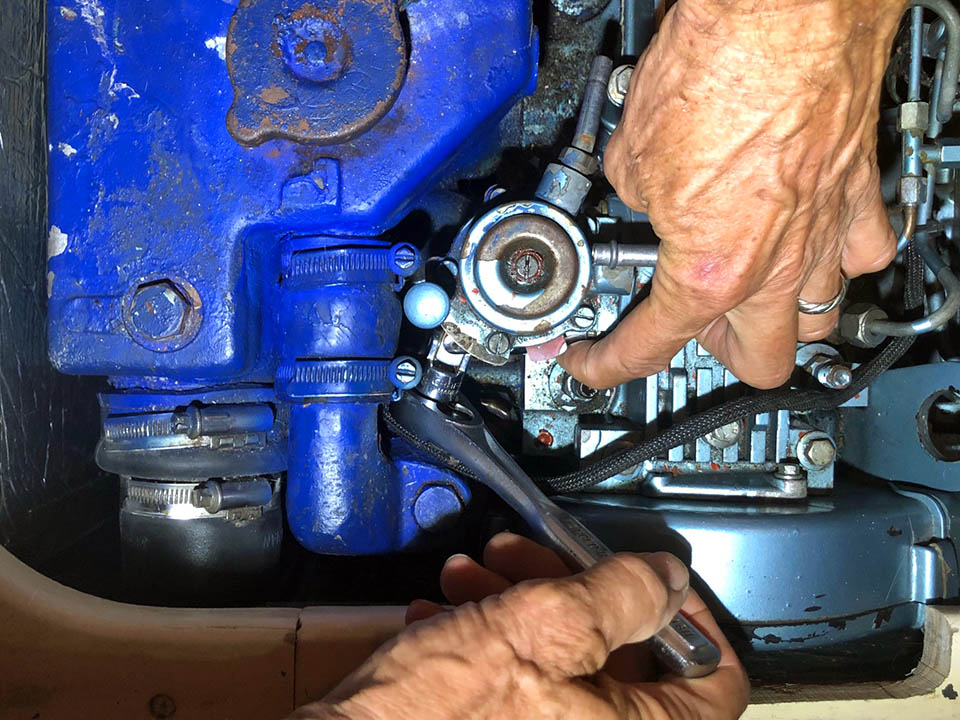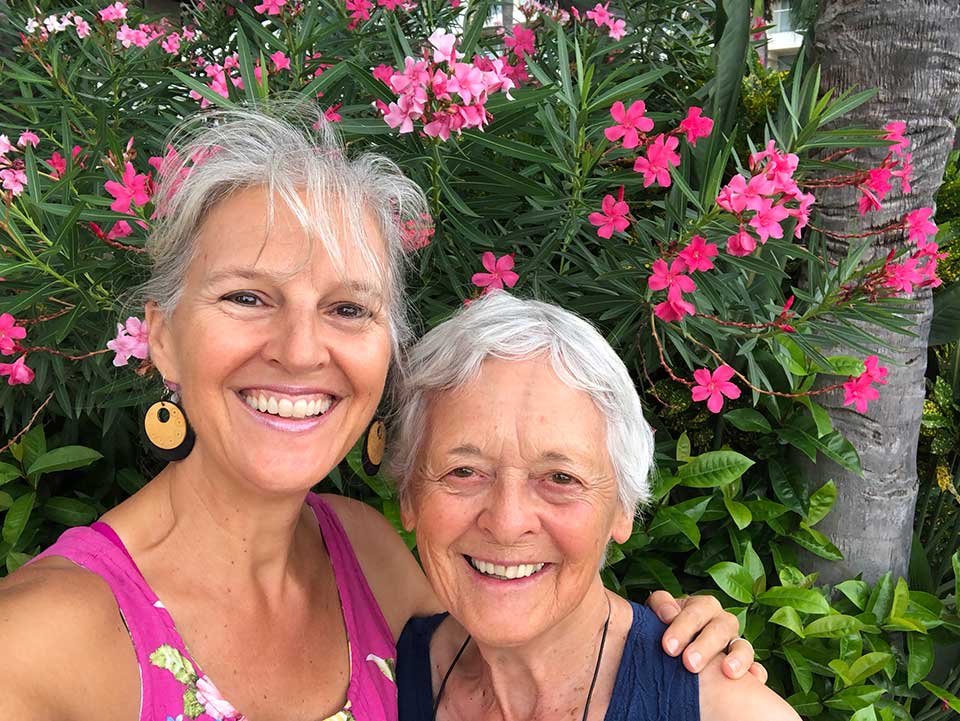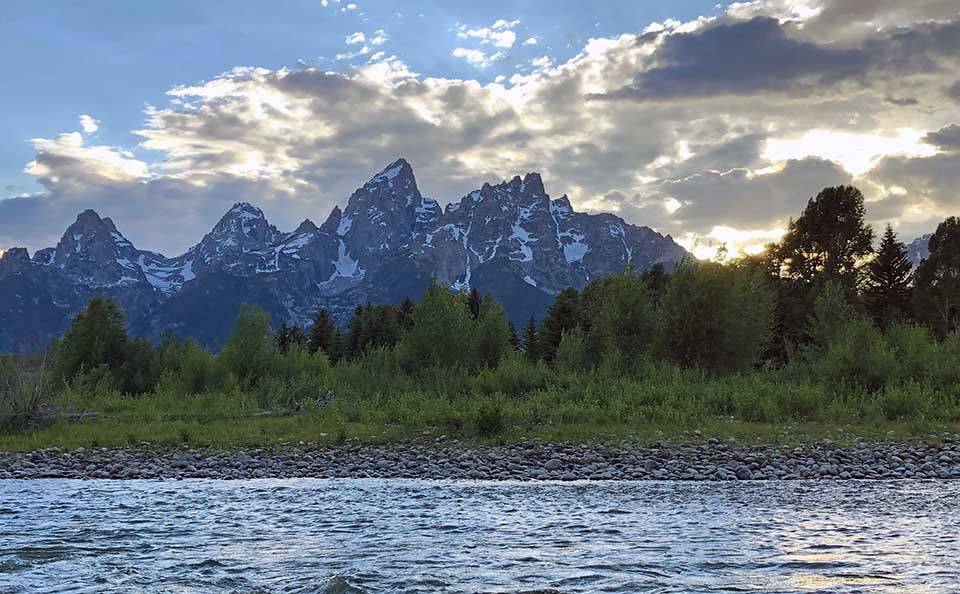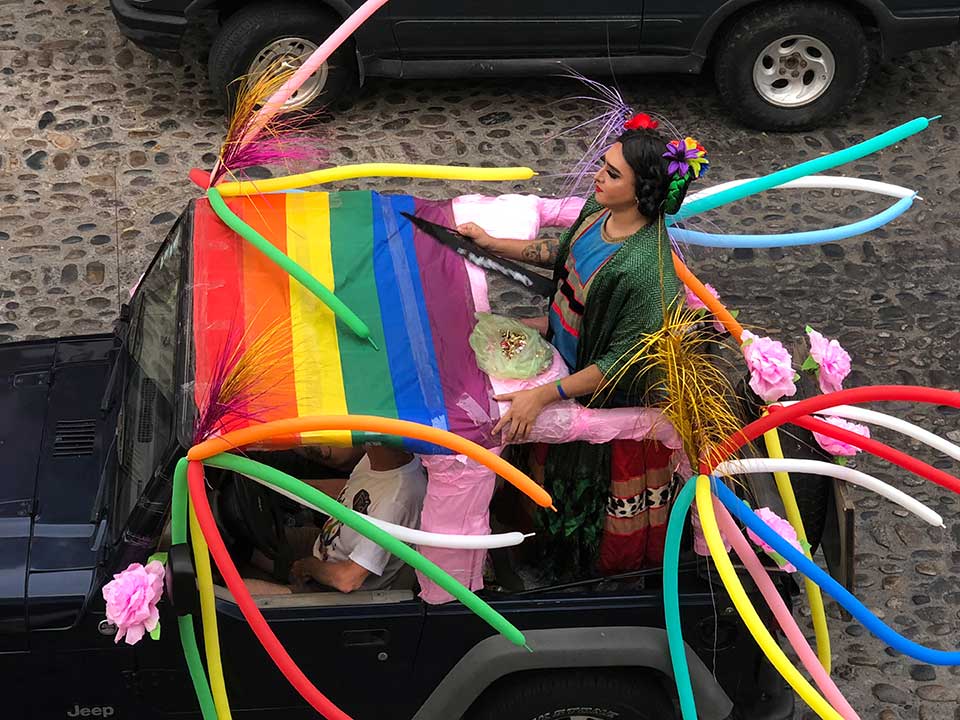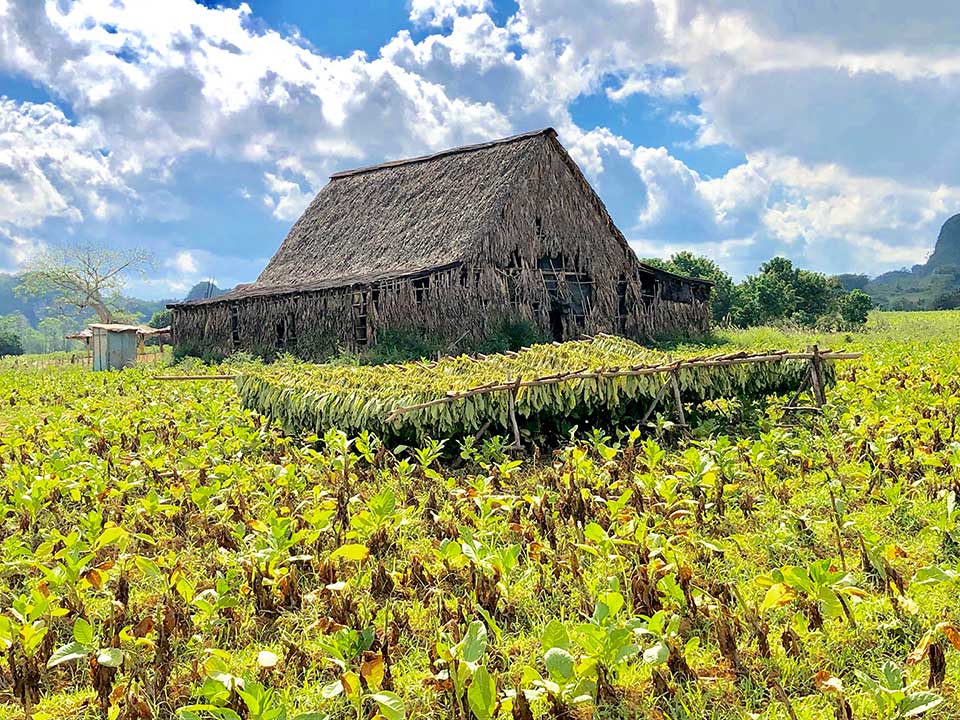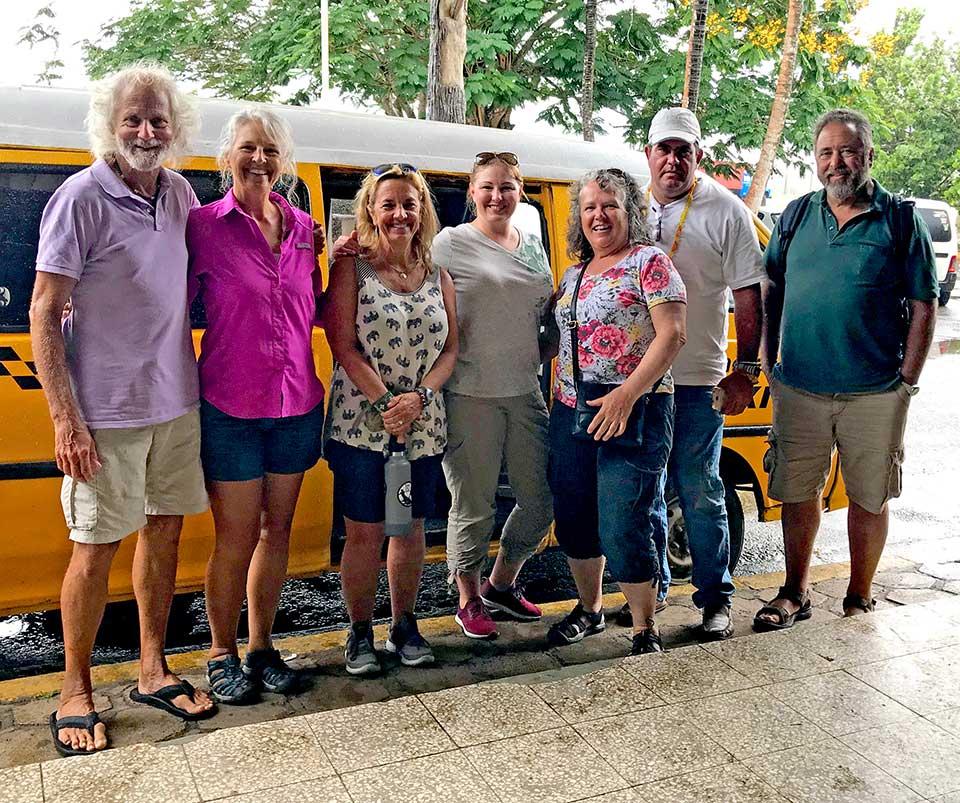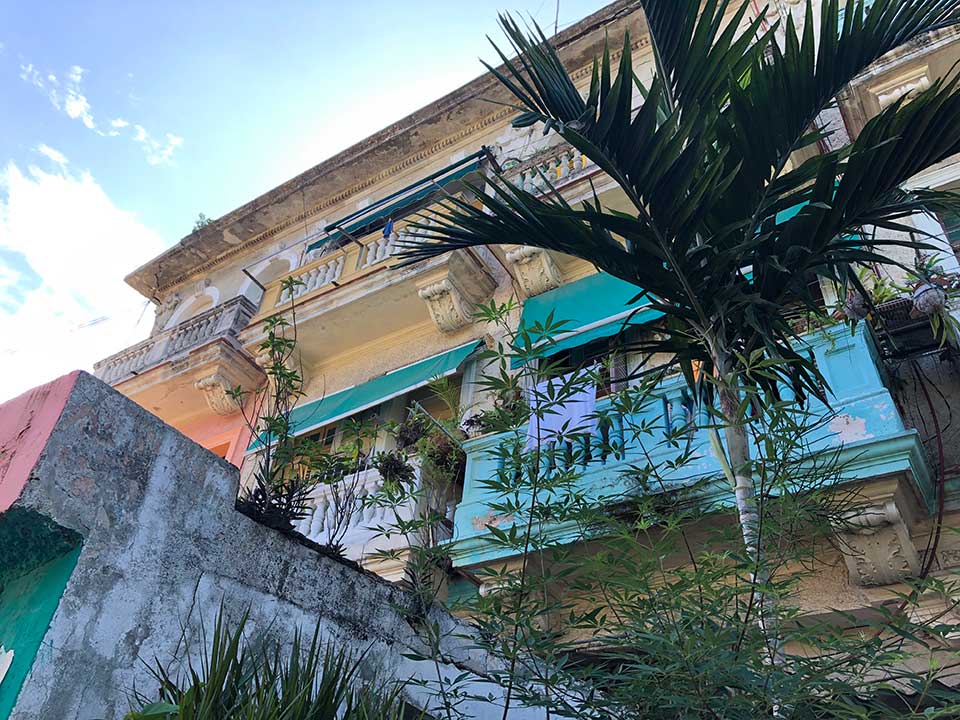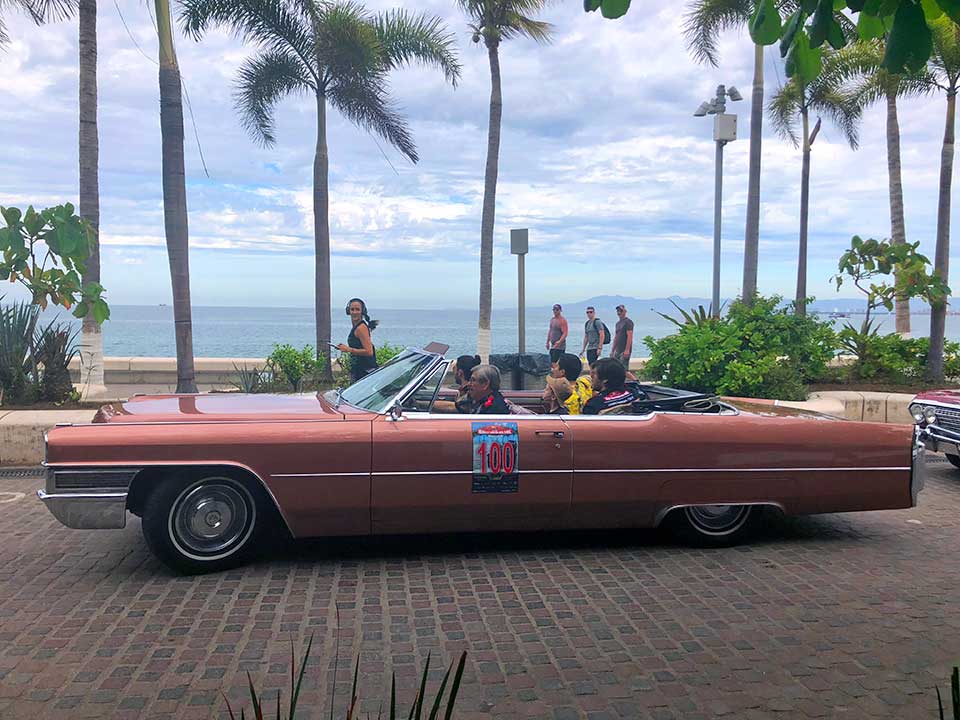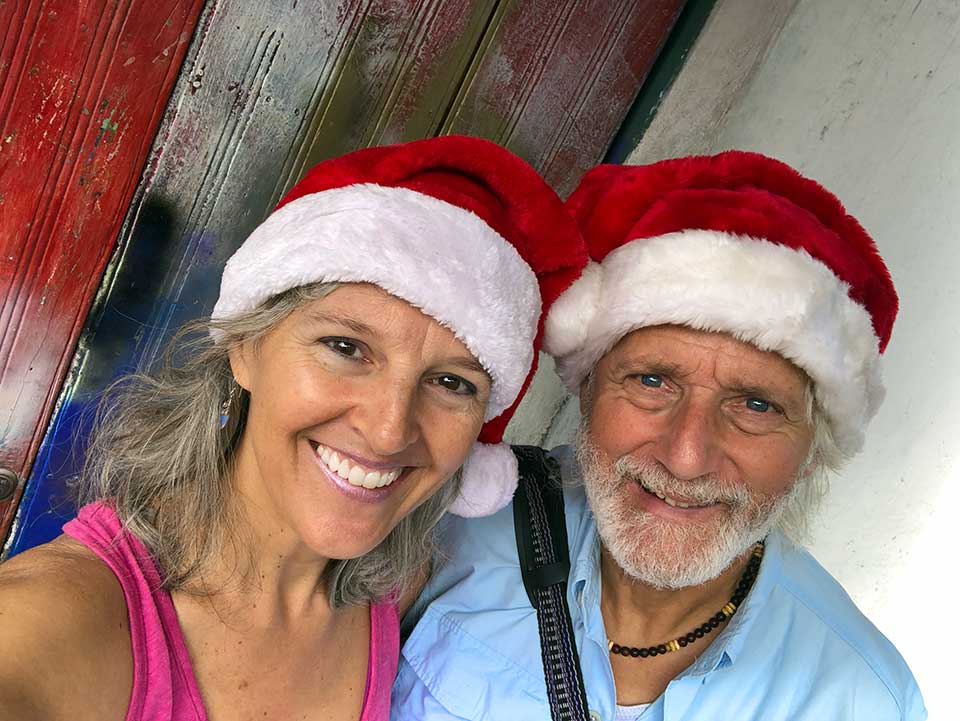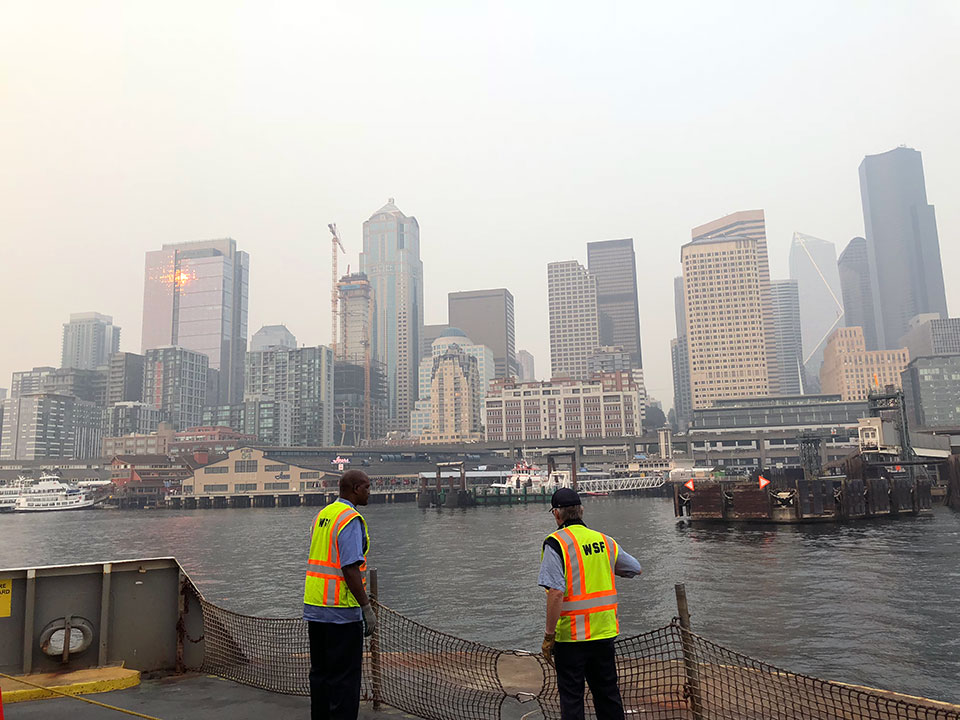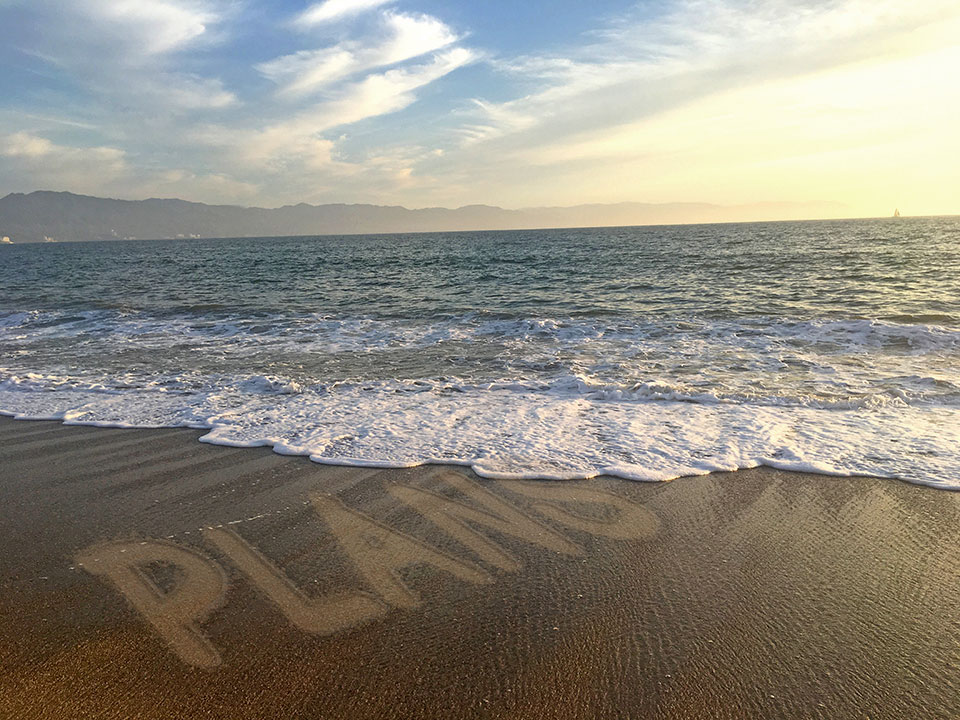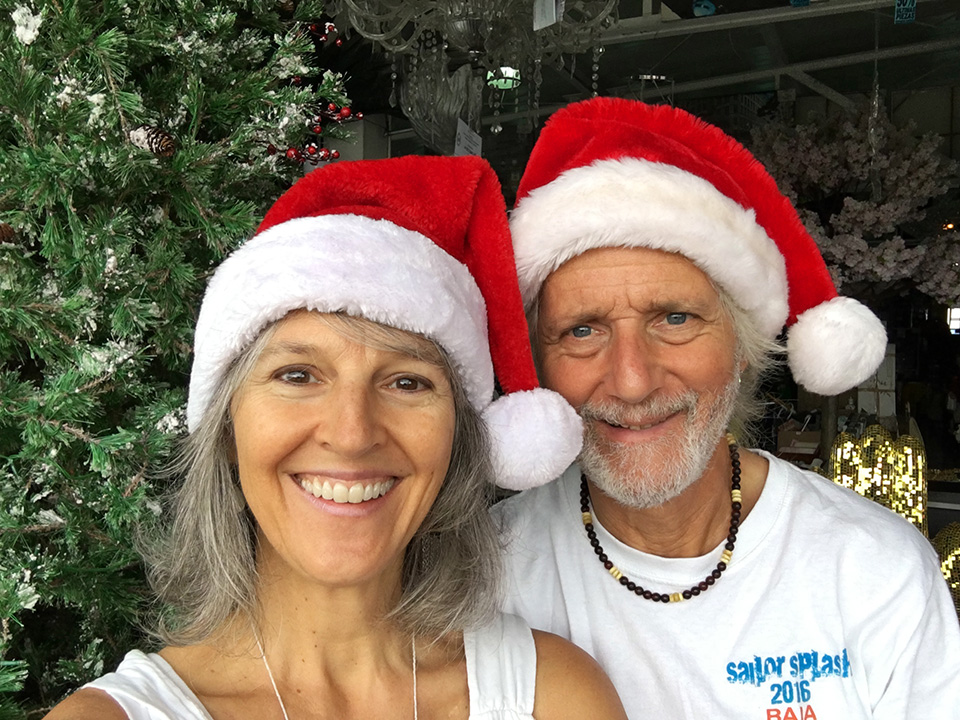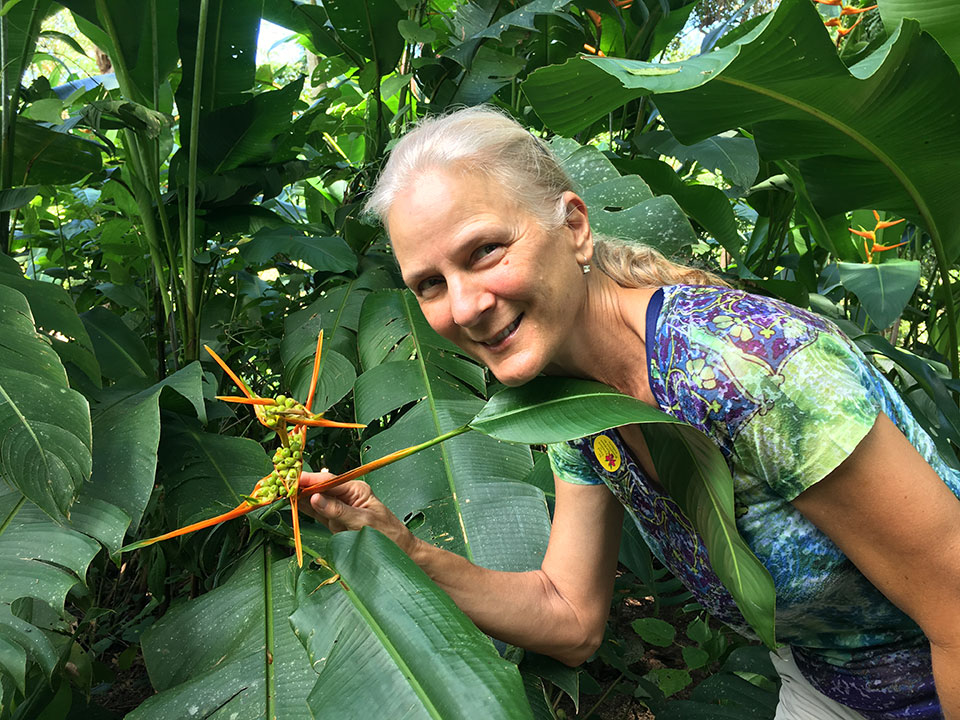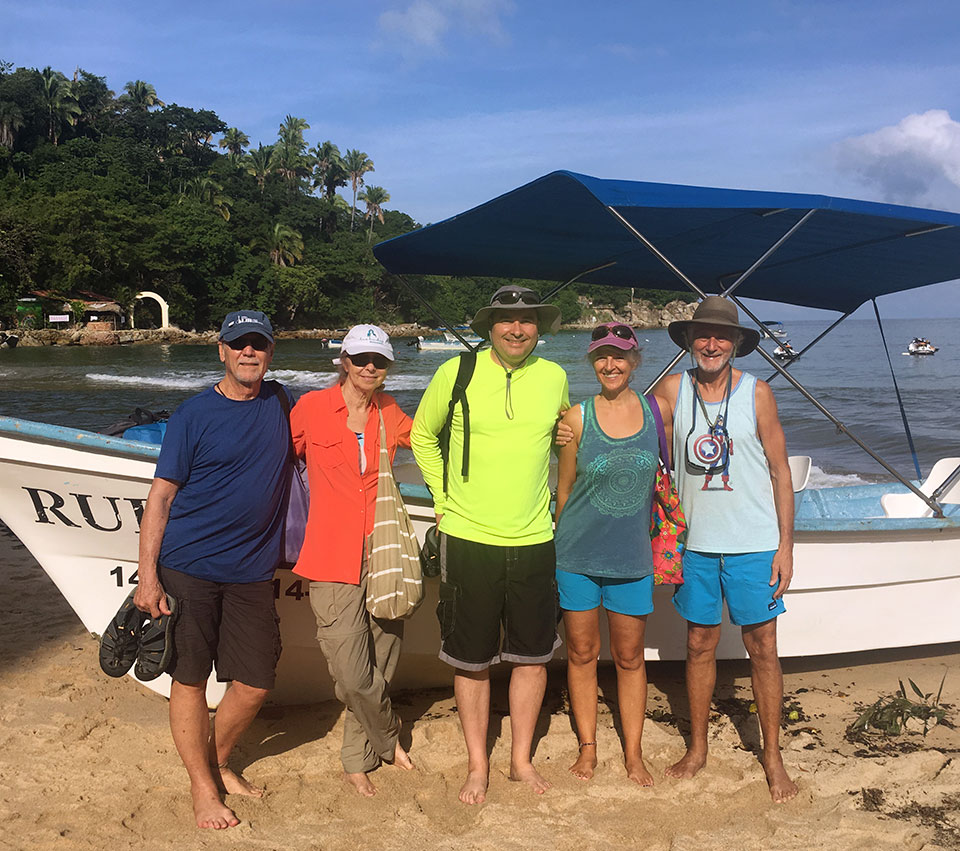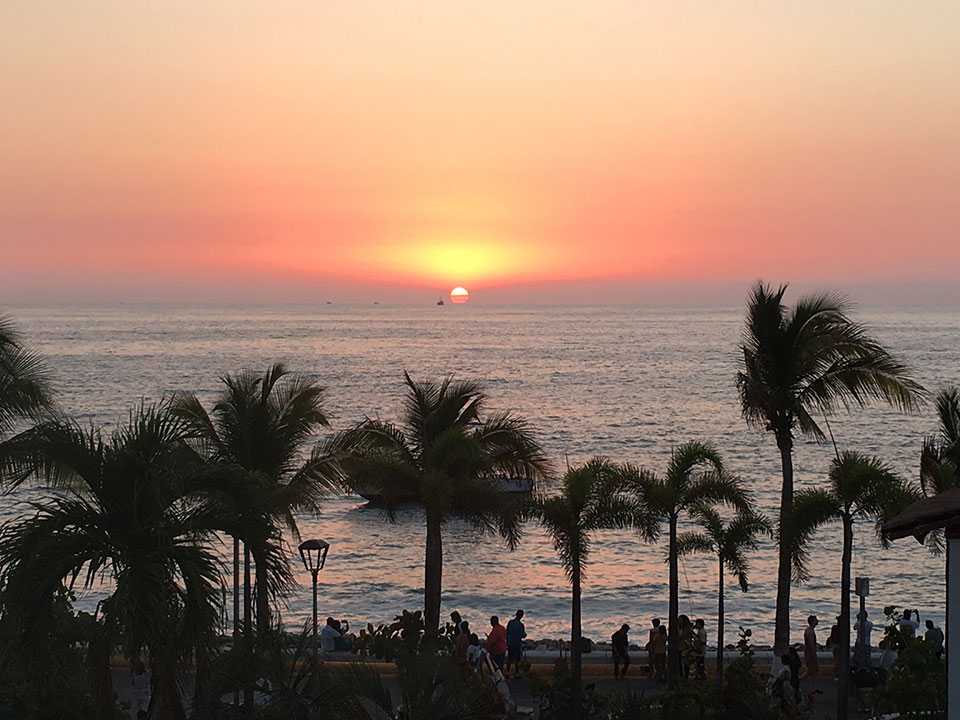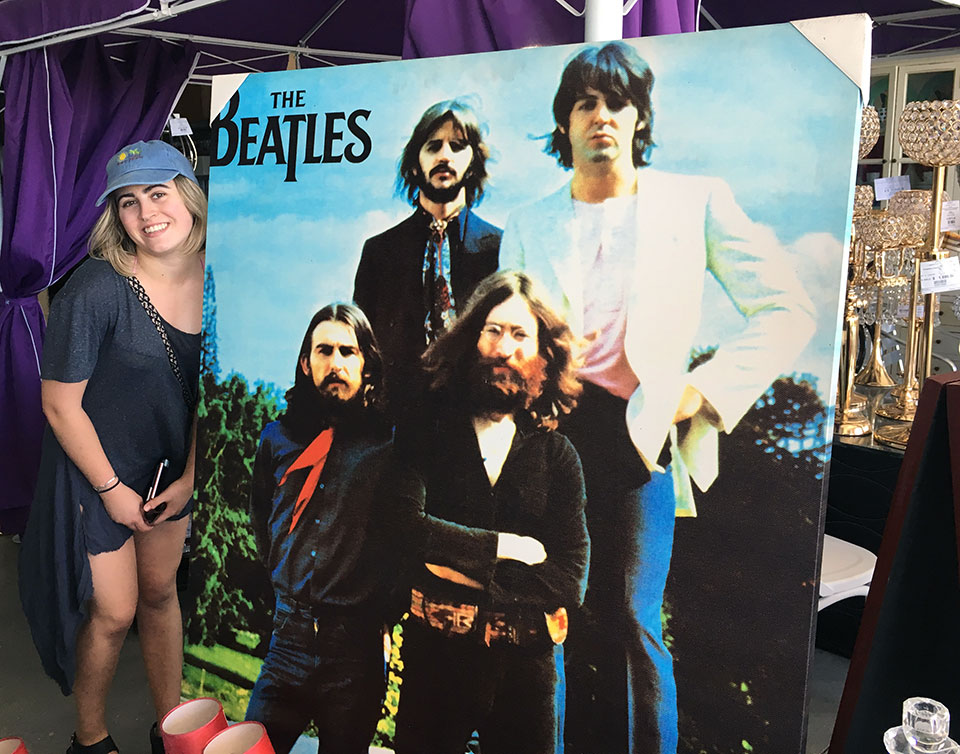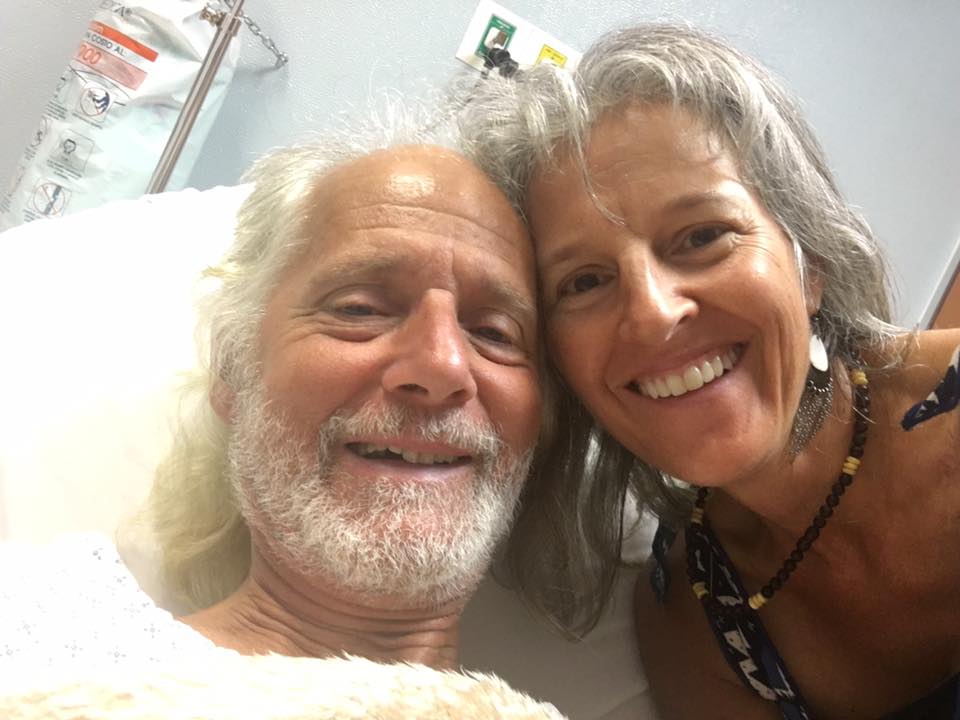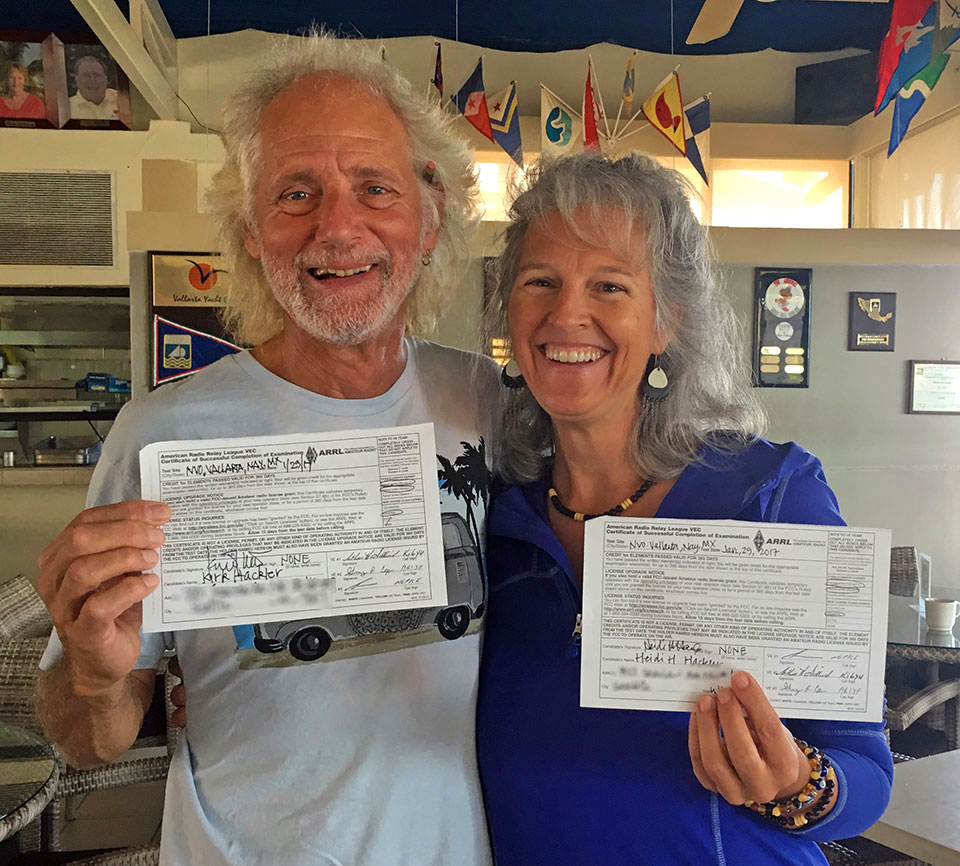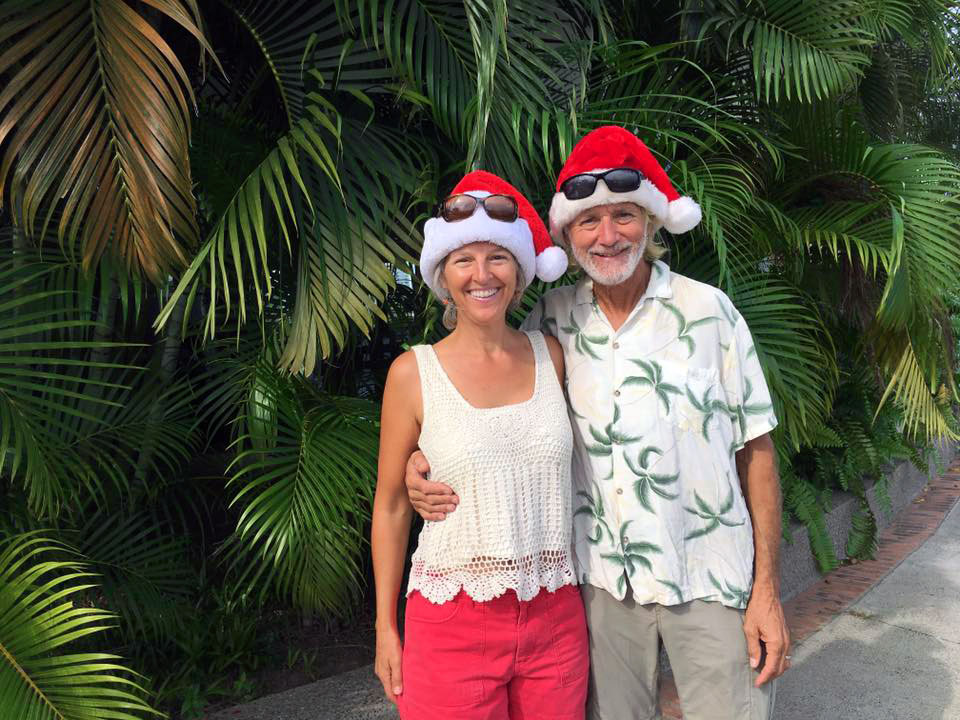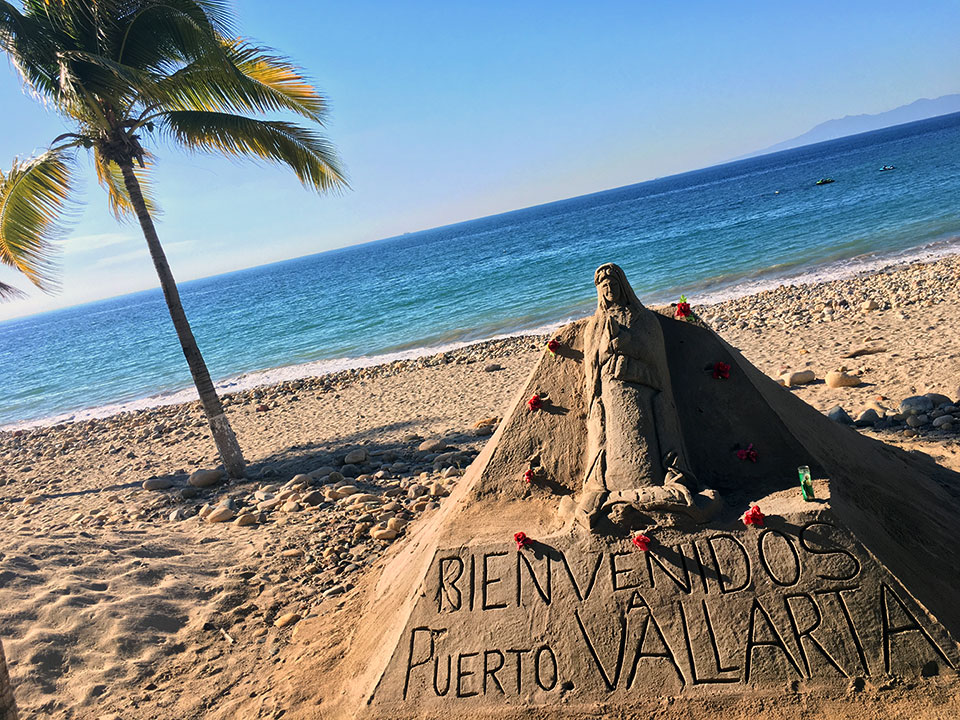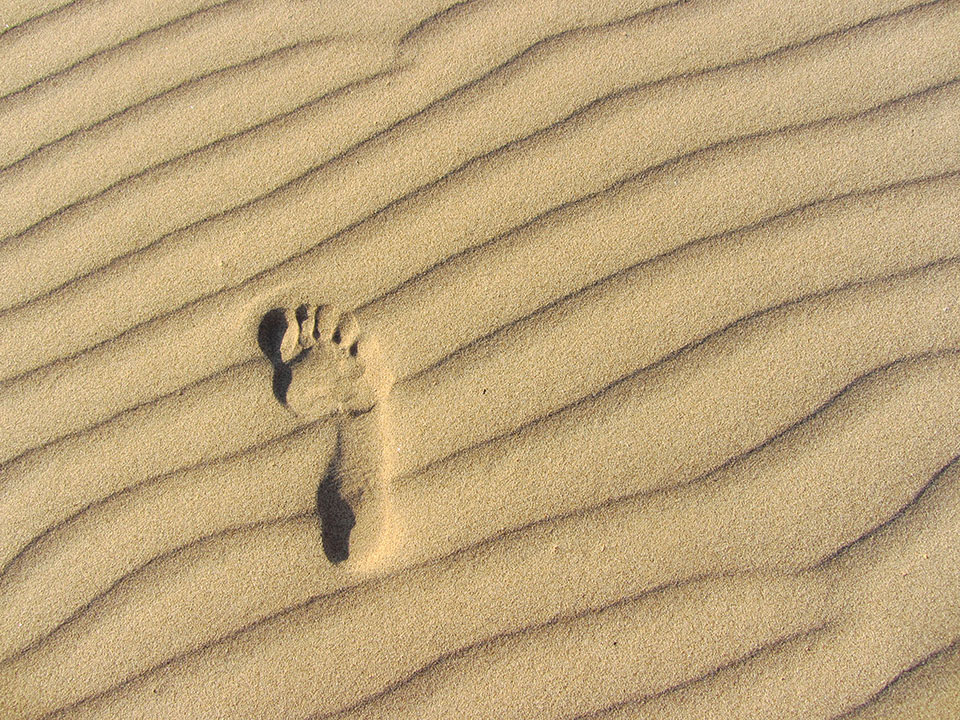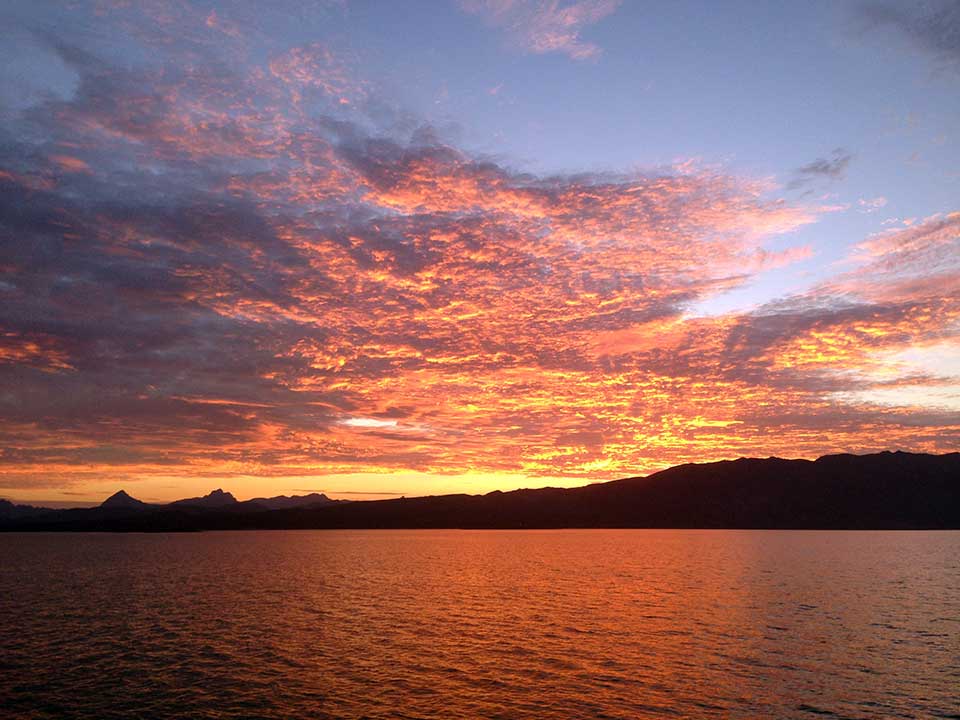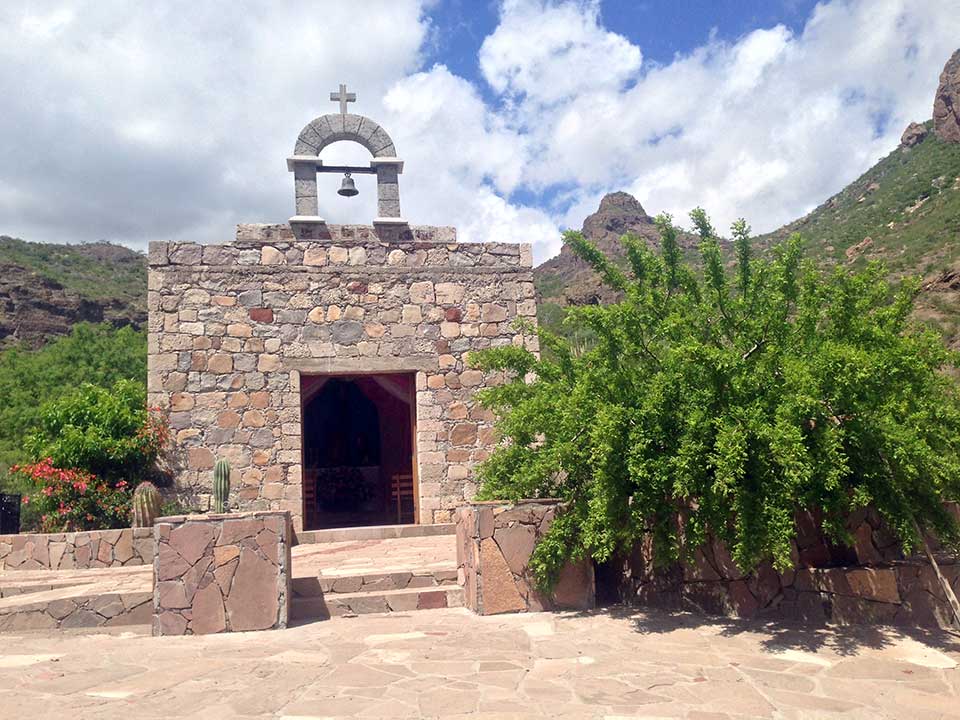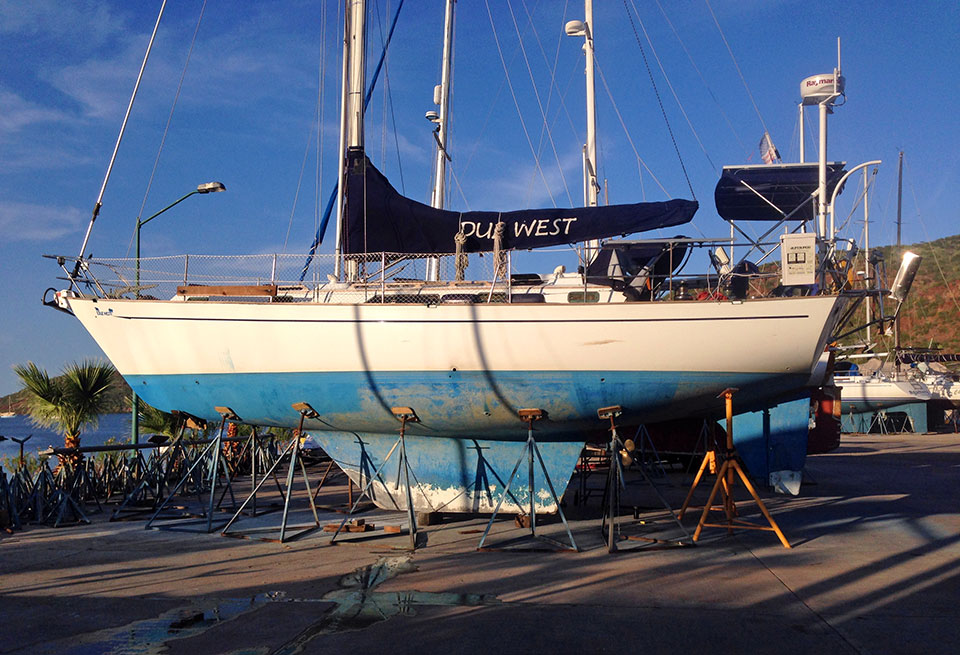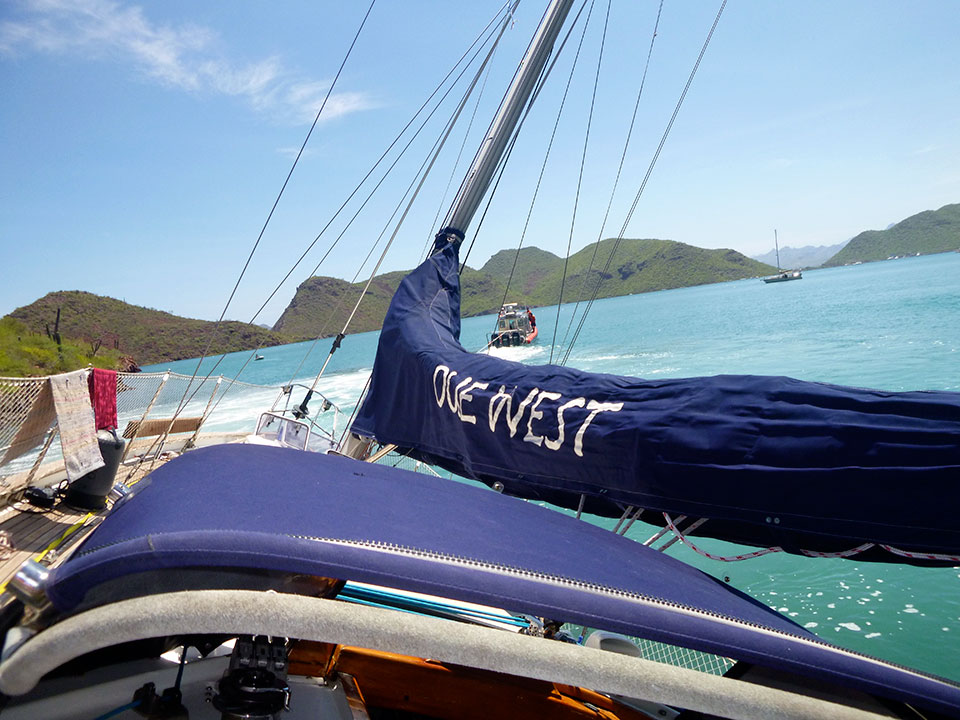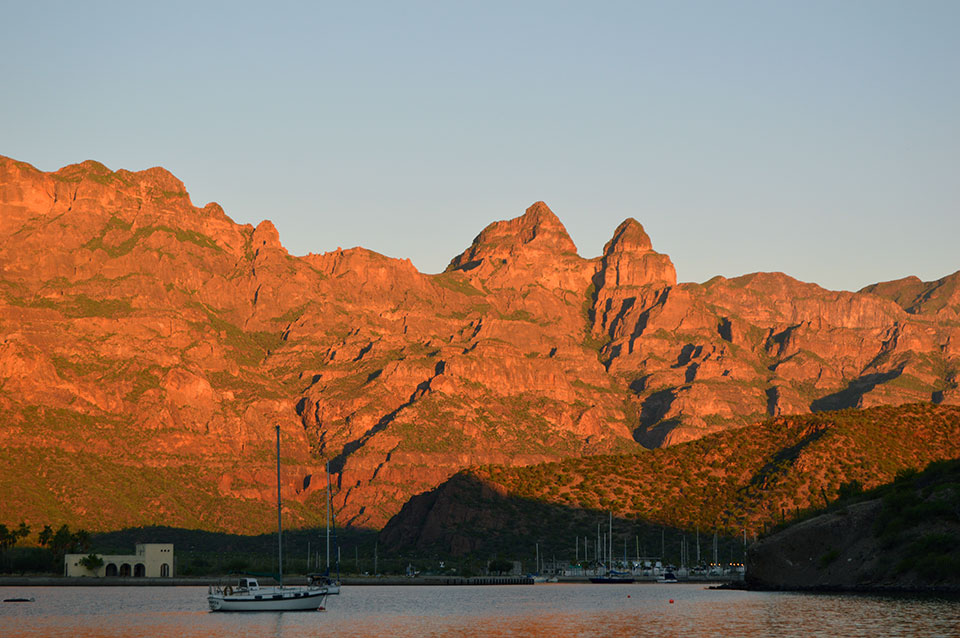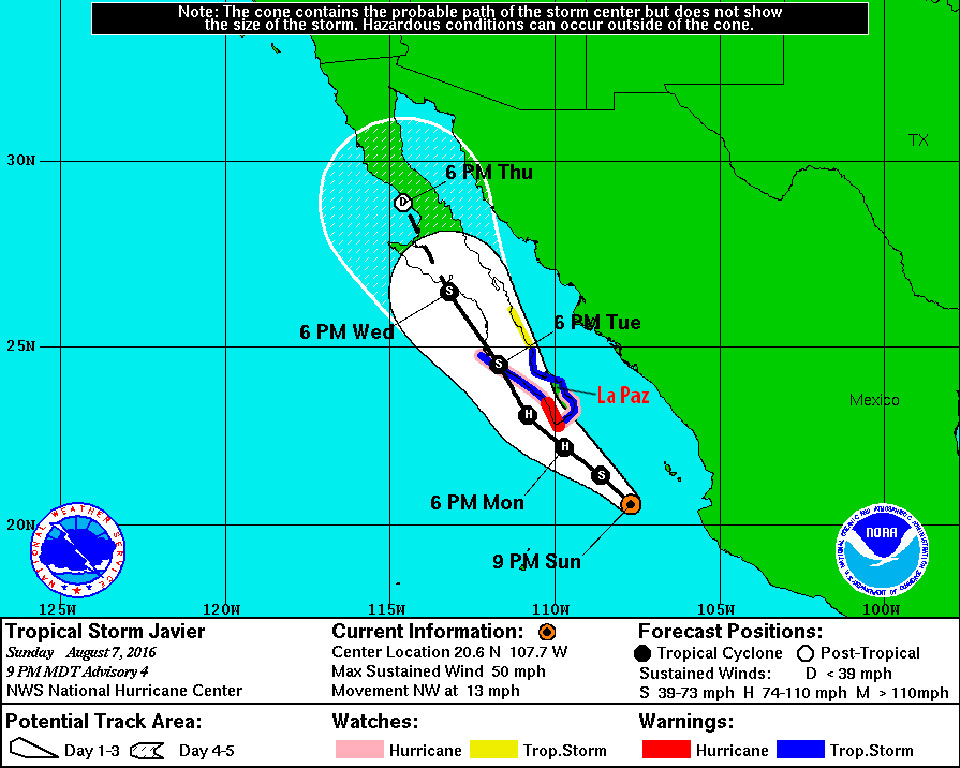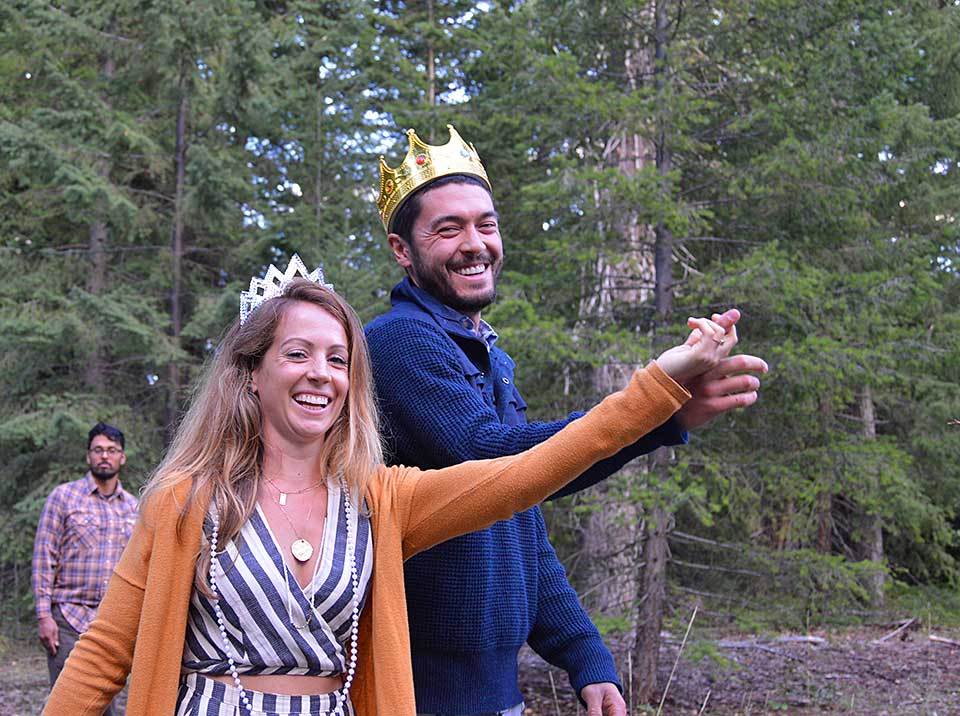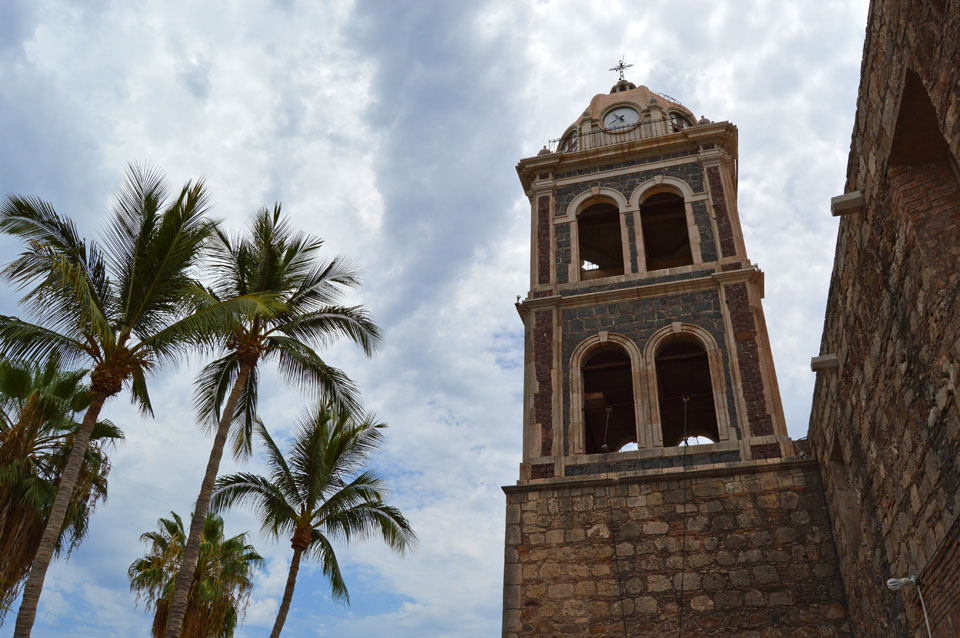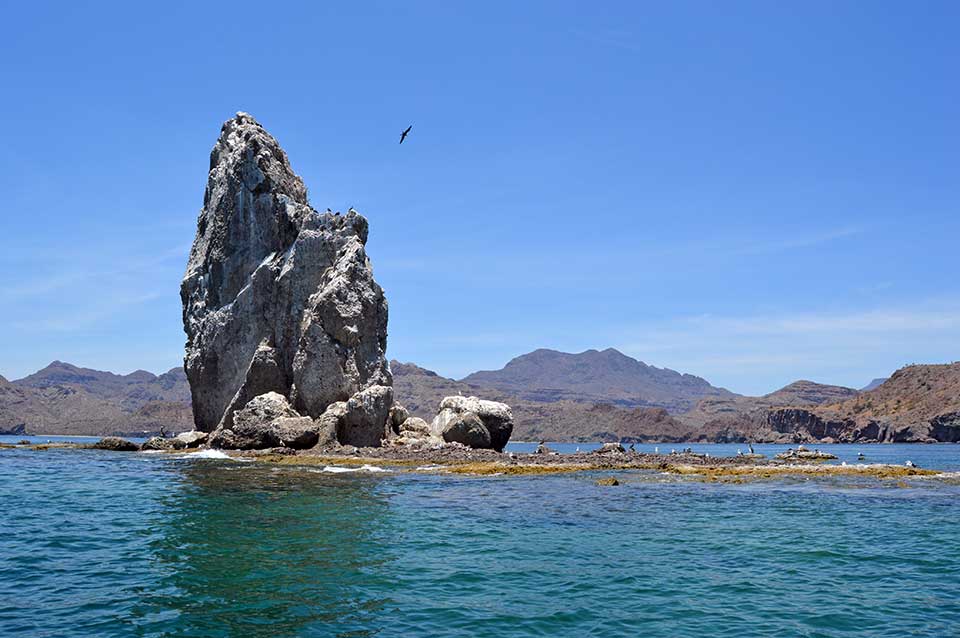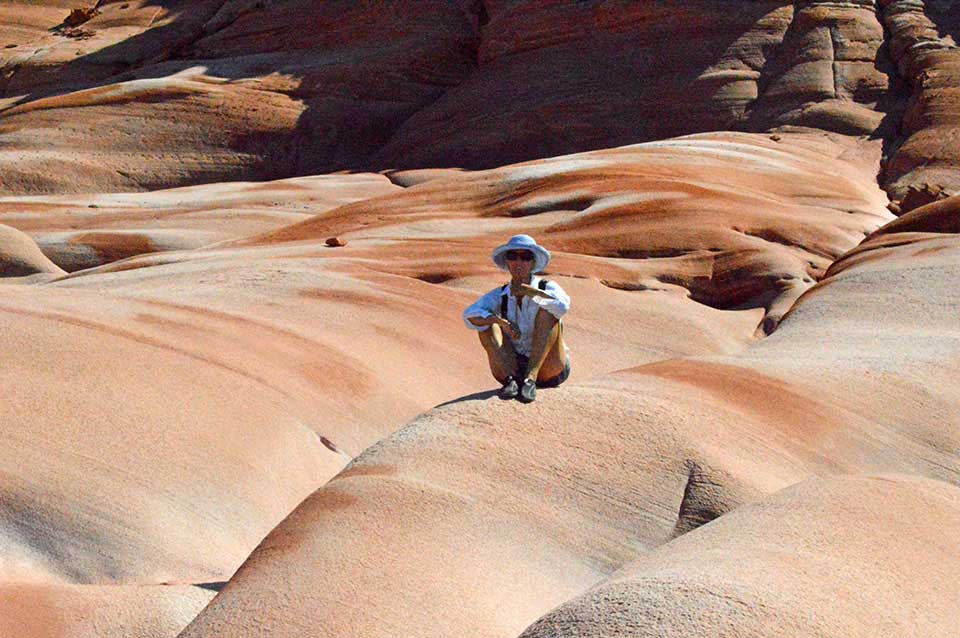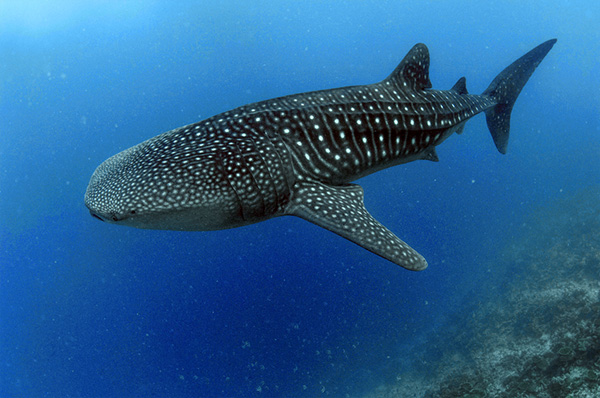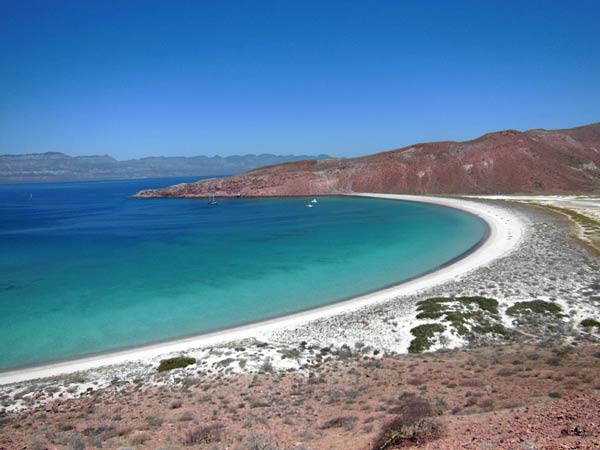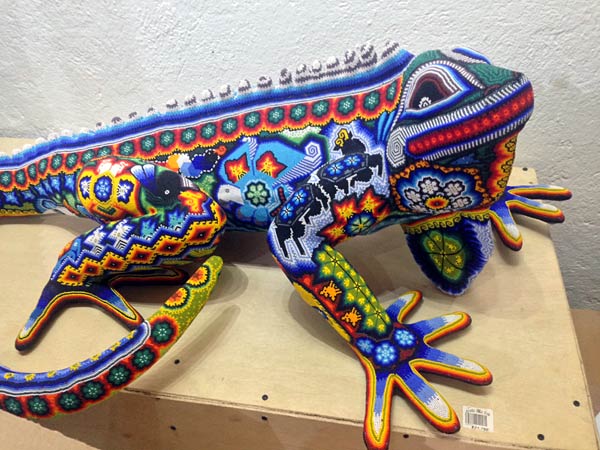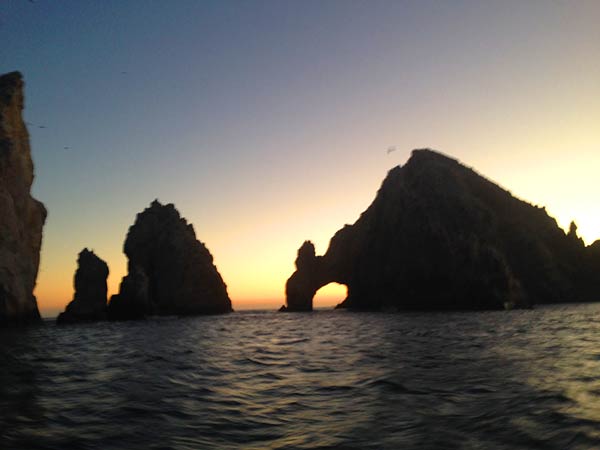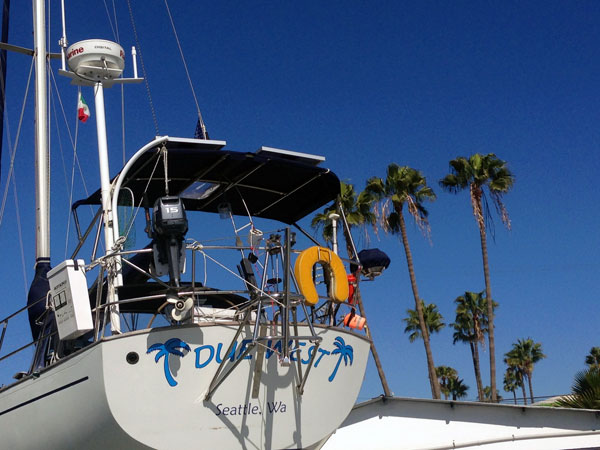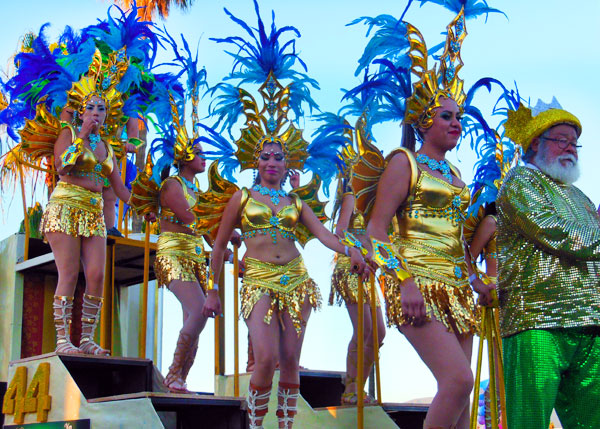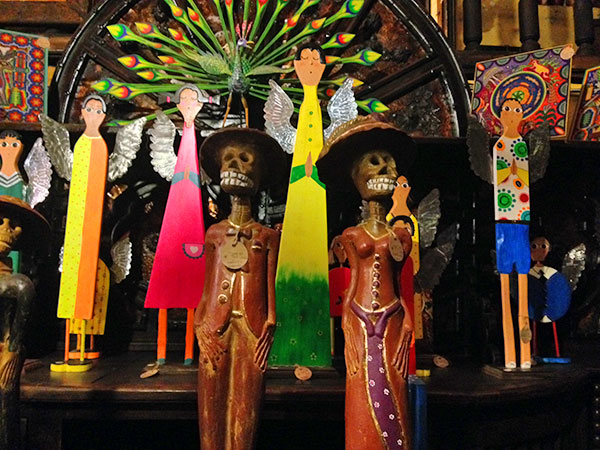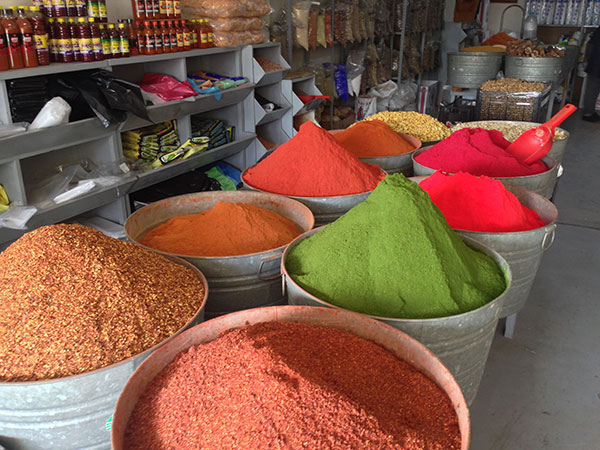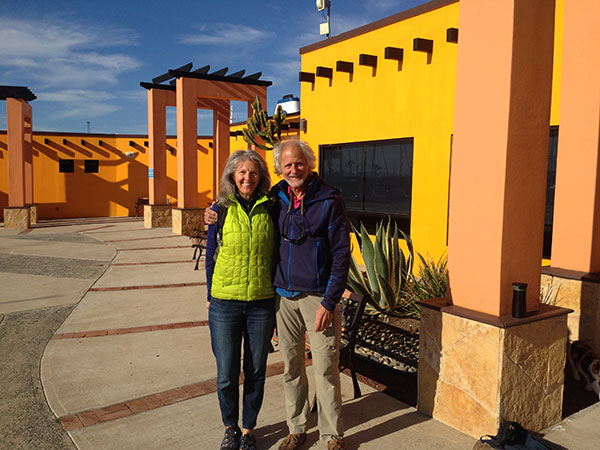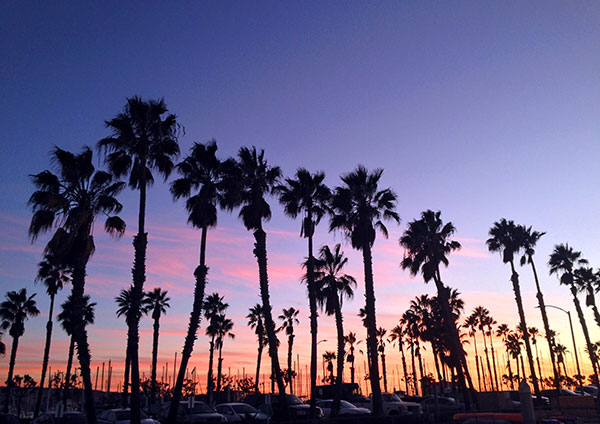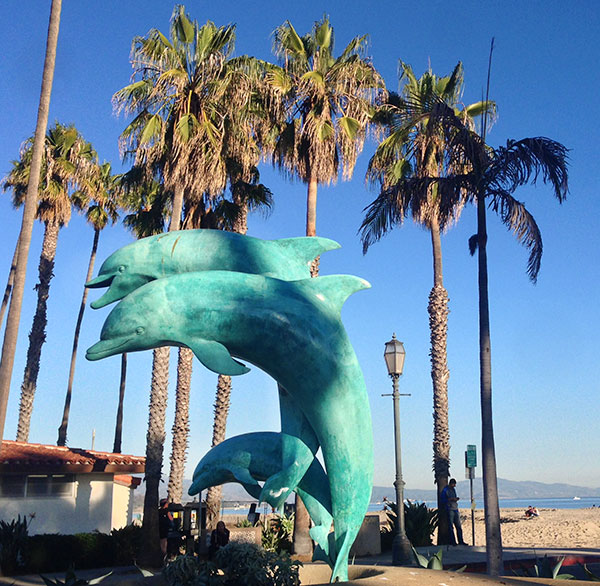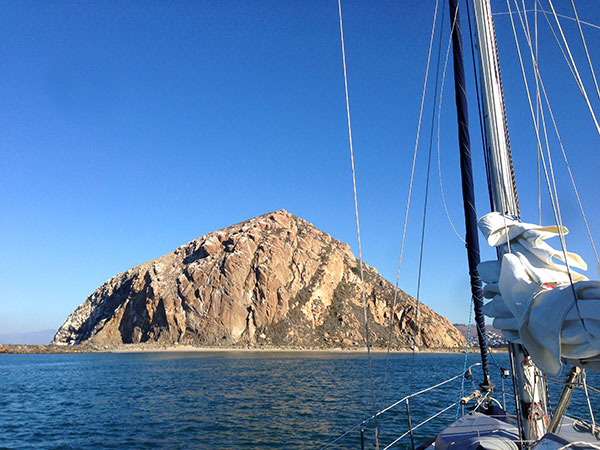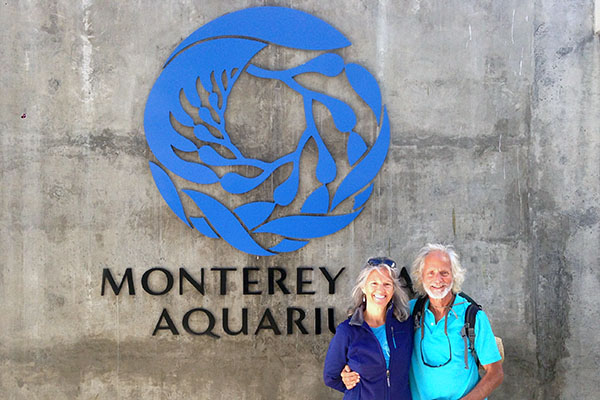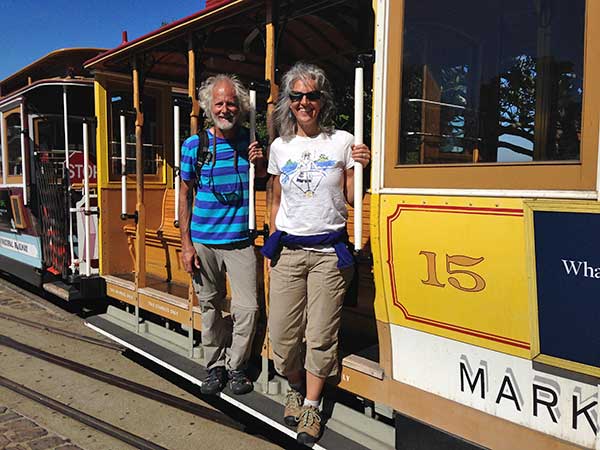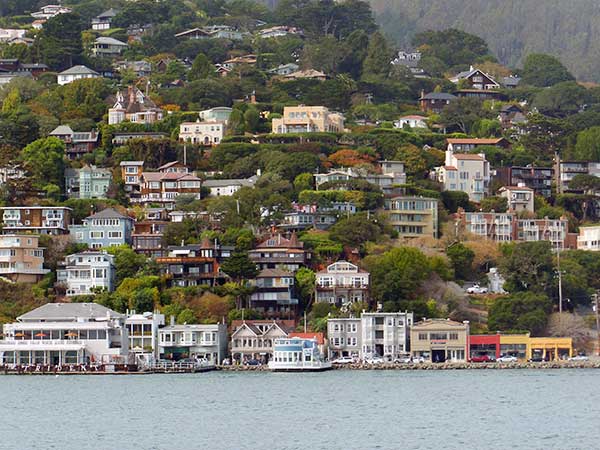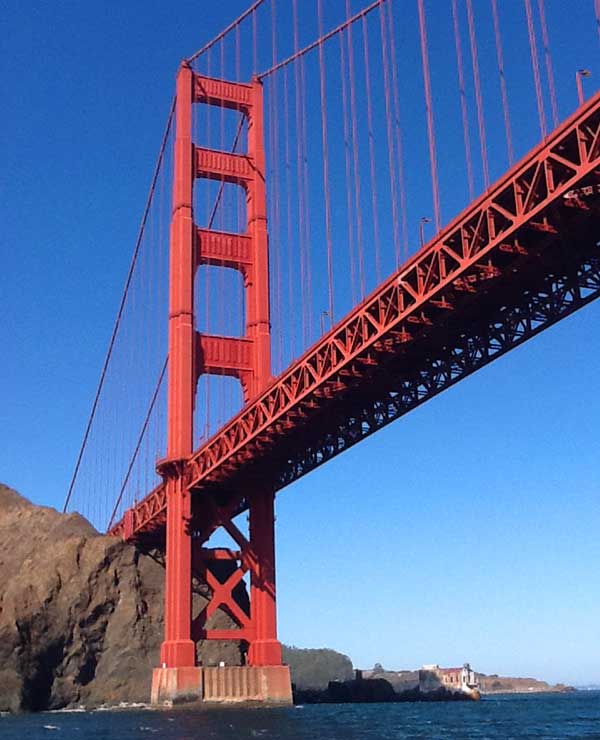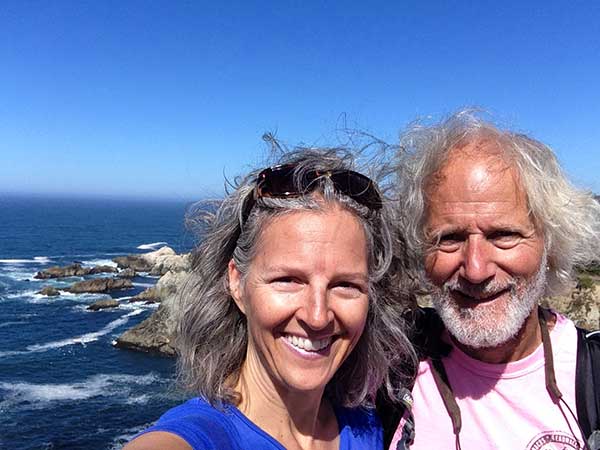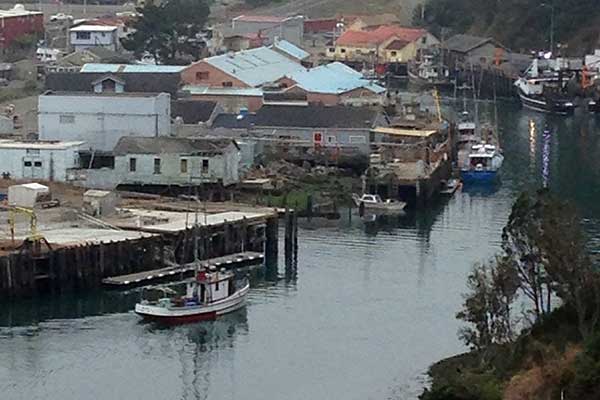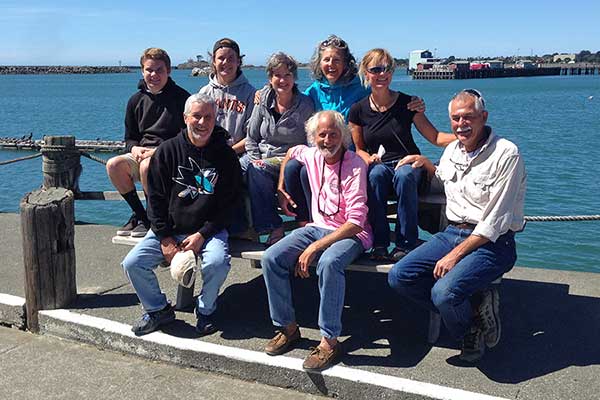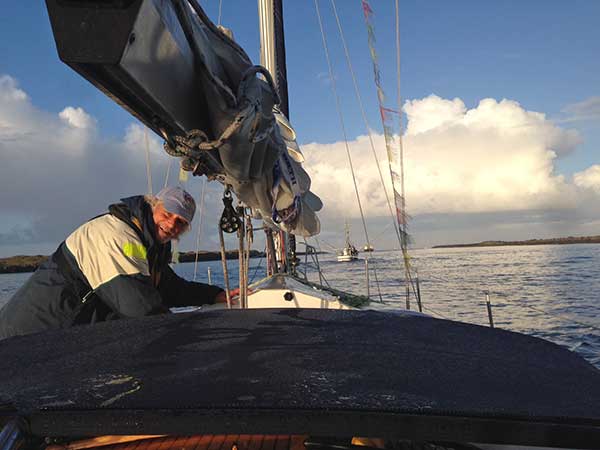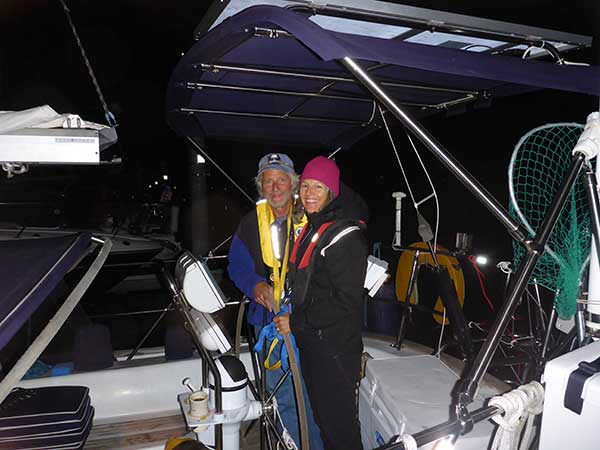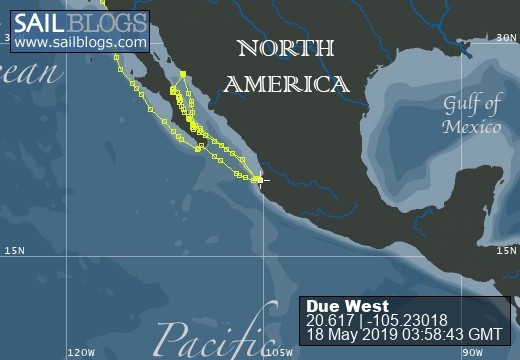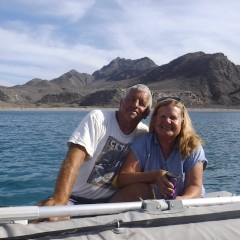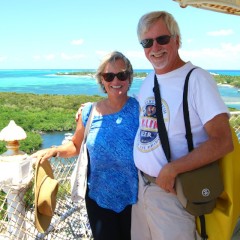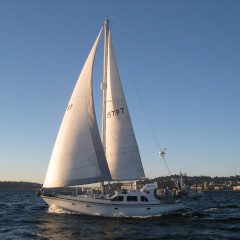
Due West Adventures
The sailing adventures of Captain Kirk & Heidi, Tosh and Tikka Hackler . . .
17 March 2019 | Puerto Vallarta
25 December 2018 | Puerto Vallarta, Jalisco, Mexico
26 August 2018 | Puerto Vallarta MX, ABQ, NM, and SEA, WA
01 May 2018 | Puerto Vallarta, Jalisco, Mexico
04 February 2018
24 December 2017 | Puerto Vallarta, Jalisco Mexico
02 November 2017 | Puerto Vallarta, Mexico
11 October 2017 | Puerto Vallarta, Mexico
16 September 2017 | Puerto Vallarta, Mexico
06 September 2017
29 June 2017 | Puerto Vallarta, Jalisco, MX
26 May 2017 | Puerto Vallarta, Jalisco, MX
07 April 2017 | Puerto Vallarta, Jalisco, MX
26 February 2017 | Puerto Vallarta, Jalisco, MX
30 January 2017 | La Cruz, Nayarit, MX
24 December 2016 | Banderas Bay, Mexico
20 December 2016 | Banderas Bay
27 November 2016 | La Paz, B.C.S. Mexico
14 November 2016 | Bahia San Carlos Mexico
17 October 2016 | San Carlos, Sonora, Mexico
Tips for New Cruisers
24 May 2016 | La Paz
Things We Wish We'd Known Before Going Cruising...
While this LONG blog post is mostly aimed at other sailors getting ready to go cruising, hopefully it will be of general interest to our friends and family as well. For cruisers setting sail from the US and Canada this summer/fall we wanted to share some things we've learned along the way--things we wish we'd known before we left Seattle, or at least before we left the US.
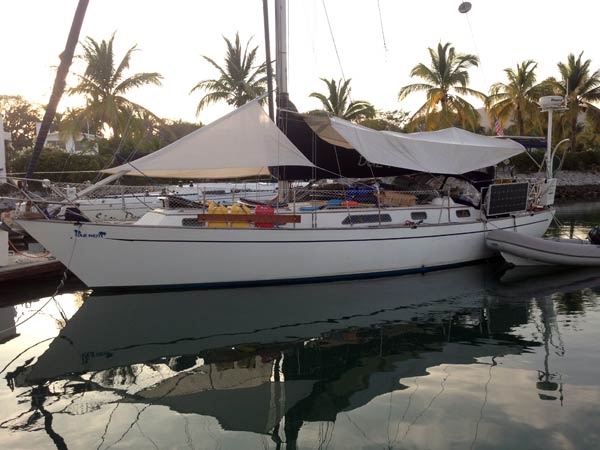
We'll be modifying our Pacific Northwest African Queen sunshade design to include mesh side panels to help shade the cockpit and house. We've also picked up some Coolaroo sun-shades at Costco to cover the bow of Due West or hang from halyards for moveable sun protection.
For the most part we are LOVING the cruising lifestyle. There are those random days when everything goes sideways, but then you have those days at home too, and it's not nearly as warm there! However, cruising isn't for everyone. We recently met a couple who were quitting after two years because they were bored...Bored??? We can't figure out how they had time to be bored. Another couple, missing their kids and grand kids, is heading home after one year of cruising. Our advice is to have no expectations, go with the flow, and enjoy life to the fullest!
If you're new to our blog, we have owned our Passport 40 for 24 years, raced her to Hawaii (Vic-Maui '96), cruised her throughout the Pacific Northwest, plus we've chartered several times in the Caribbean. We are new to full-time cruising in Mexico and beyond and by no means have all the answers. This is just our experiences over the past few months. Hopefully these tips and tricks will help others as they prepare to cruise in warmer climates.
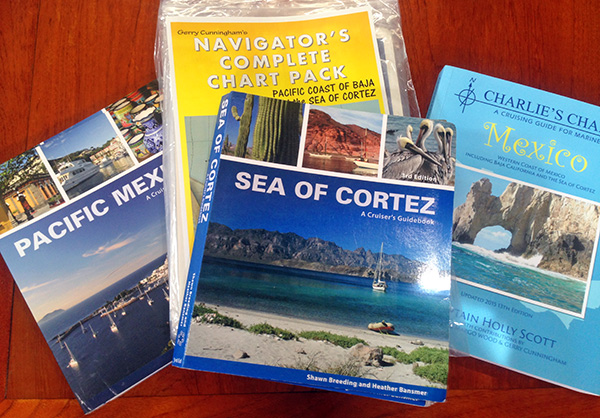
Cruising Guide Books
We love the Shawn Breeding & Heather Bansmer books, Sea of Cortez and Pacific Mexico. Their photos and descriptions are fantastic, and their waypoints are spot-on. We also have the new Charlie's Chart Mexico book, totally updated and revamped by Holly Scott, it's even perfect-bound, not comb bound anymore. And for charts we just got the Gary Cunningham Charts which are purported to be the most accurate paper charts of Pacific Coast Baja and the Sea of Cortez. Not like your electronic charts (Navionics!) which may have you 1-2 miles IN-shore in some places!?
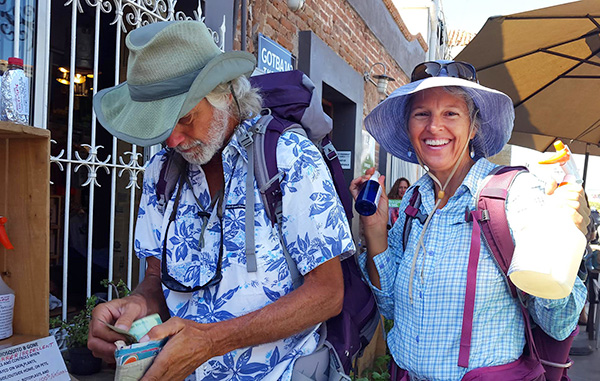
While shopping at the organic farmer's market isn't necessarily the cheapest, it is the healthiest. Here we are buying all natural, essential oil based bug repellent to spray on our bug screens. We try to pay cash for everything which helps us with budgeting.
Budgeting
Potential cruisers alway want to know: "How much does it cost to go cruising?" The truth is you can cruise on ANY budget, but some items are non-negotiable, like paying for visas to visit new countries, exit fees when you leave, etc. Many countries and/or marinas now also require you to have boat insurance. There are people cruising on more and on less than we are. We are cruising on a budget of about $2,000 US/month. We don't eat out a lot (we actually think our own home-cooked food tastes better! :-) but we've stayed in way more marinas than we planned to, which can add up.
Staying in marinas allowed us to use the free wifi, plus dock-space and electricity to finish up a few projects that were non-critical for our US cruising, but would be much needed in Mexico and beyond. (When we left Seattle we still had several incomplete projects including water maker, inverter, two more solar panels, cockpit shower, etc., which we'd planned to work on and install underway.) Another plus of staying in marinas has been the close proximity of towns, enabling us to explore and see more of the local culture.
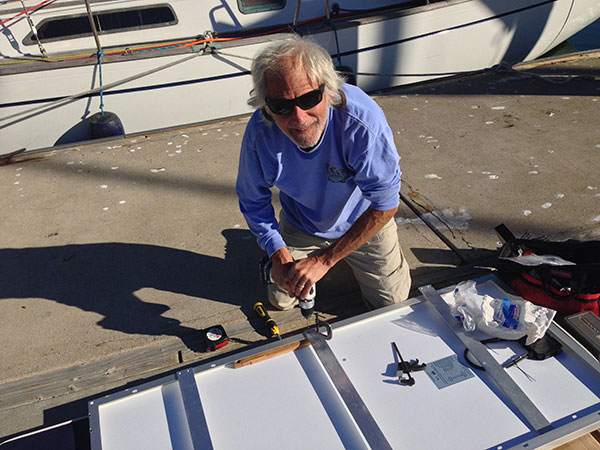
It's nice to have dock space and electricity for working on larger boat projects, but we're looking very forward to spending more time on the hook and not in so many marinas which are a budget-killer!
Though we tried our best to plan ahead for these projects before leaving home, as is true with any boat project you tackle at "home" or away, things can morph, balloon, and need more or different parts and time than originally anticipated. Because of this, we've exceeded our monthly budget almost every month since we left Seattle.
That being said, as we prepare to head north into the Sea of Cortez for the next 6 months, most of our major installations will be done, and there will be very little for us to spend any money on other than food (cheap!) and some fuel depending on how much wind we have for sailing, so by year-end we should still be within our annual budget. Of course there are always maintenance and repairs to be done which brings us to spare parts...
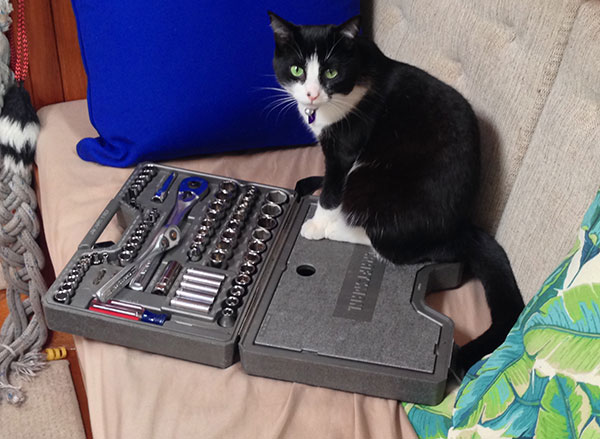
We try to have as many spares as possible, including things like tools. Tikka (and Tosh) are ever helpful when it comes to tools and parts and boat projects! ;-)
Spare Parts
Before we left Seattle we tried to anticipate every possible spare part we might need. We'd heard from friends cruising in Mexico and beyond that it's virtually impossible to get spare parts shipped to you. So much so that many people will buy a plane ticket home, buy everything they need, and bring it back in their luggage, as this can be cheaper as well as a more reliable way to ensure you are getting the exact parts you need. Or you can have friends and family bring you parts when they visit.
While there are some marine chandleries here and there in Mexico (at least three in La Paz, and a couple in La Cruz that we know of), their prices can be two-to-three times that of the US, and they often don't stock what you need. Factory reps for electronics also vary widely so it's prudent to ask around to see who is recommended.
Of course it's impossible to second guess everything you'll need! But we did our best, and stocked up on lots of things like pumps, pump rebuild kits, head rebuild kits, nuts, bolts, screws, paints, etc. And still there are things we need to get when we go home to visit: spare alternator, spare starter, two 4-part blocks (to make our dinghy hoist system, see below), etc.
Occasionally you get lucky! Like just the other day when La Paz Cruiser's Supply had the exact part that Kirk needed for the watermaker installation. And then when Kirk was looking for a machine shop to drill and tap a hole, we met another cruiser with a full machine-shop onboard who was happy to do it for us! Thanks Michael & Didi!
As for trying to have items shipped to you, if they make it past customs without being "lost", there can be a hefty import tax. We've recently heard that the old method of having your TIP (Temporary Import Permit which you will pay for and receive at your first port of entry into Mexico) be your golden-ticket to importing anything for your boat... no longer works that way. But no one really knows quite how it's supposed to work now... and by the time you read this it may have changed again. We have had several friends bring items to us, and we will be going home for a visit and stocking up on things we can't get here as well, like good jerry cans!
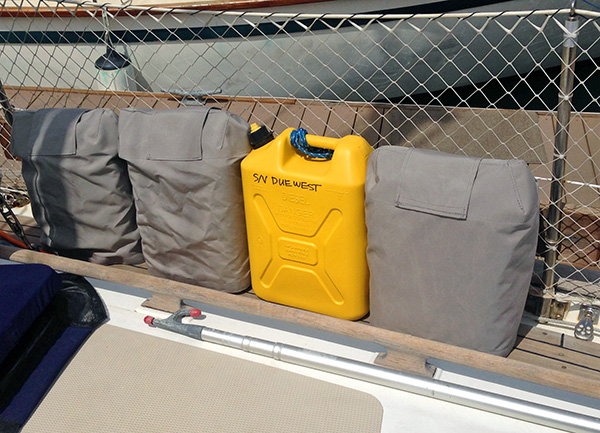
Our canvas jerry can covers help protect the plastic from the sun, and the fuel from the heat. We have 2" x 6" lashing boards on each side of the foredeck to lash our jerry cans to while under way. We also had the jerry can covers made with velcro handle covers, so that the whole can can be covered, or we can uncover the handle for carrying them with covers on.
Jerry Cans
In case you're not familiar with jerry cans, they are 20-liter (~5-gallon) plastic storage cans for extra diesel, gasoline or water, (based on a design from WWII and Korea.) We bought some in San Diego before we left the states. Jerry cans can be very helpful if you're traveling to more remote areas where fuel is harder to come by. We originally purchased 4 for diesel (yellow cans), 1 for dinghy gasoline (red), and 1 for water (blue.) And we already had a small 2-gallon red gas can for our Honda 2000i generator (see below.)
We soon realized where we'll be going, we wanted to have more diesel capacity than the jerry cans we'd purchased in the US and wanted to buy two more yellow cans for diesel. Unfortunately they are very hard to come by in Mexico, and if you can find them they will cost twice what they do in the US, making them cost prohibitive to our budget. We did find some cheap Mexican knock-offs, which likely won't last as long as the ones you can find at home but that's what we have for now.
Figure out your extra fuel (or water) needs before you leave home, and stock up accordingly. This will vary depending on your own tankage volume and where you plan to cruise, if you have a watermaker, or how long you are willing to sit in little to no-wind before you get somewhere. We carry a generous 120 gallons of diesel in our tanks, so with the extra jerry cans full we now have fuel capacity of 150 gallons, or about 700-1,000 nautical mile cruising range depending on wind assist.
Honda 2000i Generator
Our veteran cruising friends had recommended we get a small, portable Honda 2000i generator before leaving the US. We actually bought ours a few years ago in Oregon to save on sales tax, and used it many times cruising in the San Juans and Gulf Islands. So why would you need a generator? Because we don't have our inverter installed (yet) we mostly use our 2000i generator to charge our laptop computers (Apple has yet to come up with a 12-volt car charger!?) and for running power tools, the vacuum, our Vitamix, etc. when we're on the hook.
The Honda 2000i is very quite and very fuel efficient, burning about one gallon for 6-8 hours of use. You can even charge the house batteries (rather than run the boat engine) and/or jump the starting battery from it if need be. For safety, due to the potential of fumes, it lives on deck and is always locked to the boat when not in use.
Amazingly, we even purchased an in-hatch air conditioner unit (from another cruiser) to help cool the boat down for our cats when it gets into the 100°s this summer in the Sea of Cortez. This A/C unit will run on the Honda 2000i as well. Our generator has come in very handy on more than one occasion, and we're glad we have it. Plus we found a Honda 2000i canvas cover online to help protect it from the sun.
Canvas Covers
Speaking of Sun protection...the sun is HOT in Mexico, very hot! For those of you who know Heidi and her penchant for wearing fleece and down jackets (and Kirk's motto of "A warm Heidi is a Happy Heidi"!) you may be surprised to hear that Heidi has met her match. She's actually proclaimed being TOO HOT!?! on several occasions...and summer isn't even here yet! Many days the inside of the cabin is 85-90°. But we digress... the SUN is HOT. And beats down on your boat and everything on it relentlessly. Because of this you need canvas covers for EVERYTHING.
When we left Seattle we had a large "African Queen" awning that we used for rain/snow protection (see top photo.) We're now experimenting with modifying that to include mesh side panels, and a front section to shade the bow. But are wishing we'd had this done sooner, for more effective sun protection now. In the meantime we bought some 13' Coolaroo awning triangles from Costco that are helping us make do.
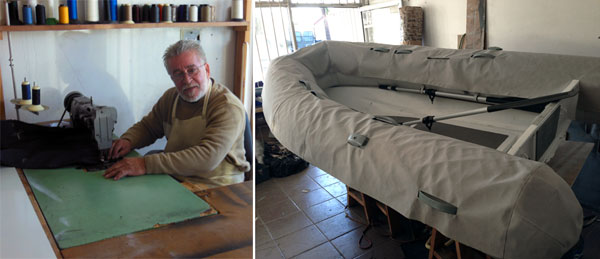
William "Bill" Solares at Ensenada Custom Upholstery, in Ensenada, MX is the best canvas worker we've encountered. Our advice is to stop in Ensenada on your way down (Cruiseport Marina) and have all your canvas work done by Bill there. Phone: +52 646 198 1678. We've actually contemplated taking the bus back up for more canvas work!
We knew from our veteran cruising friends that we wanted to have dinghy chaps before we got to warmer weather, so we had those made by William Solares at Ensenada Custom Upholstery, [phone: +52 646 198 1678], in Ensenada. William used to live in the US and has great English in case your Spanish isn't quite up to snuff. He was fantastic to work with, has excellent craftsmanship, and at very reasonable prices...now that we're in La Paz we are trying to get more canvas work done, and after dealing with three different no-shows, and another guy who's been a bit flakey, we wished we'd had William do everything. Unfortunately we didn't know what all we needed when we were in Ensenada (and we probably still don't!) William was in close-proximity to San Diego and could get everything needed in the way of supplies. Further south in Mexico, we've been advised that it's best to supply all of your own materials.
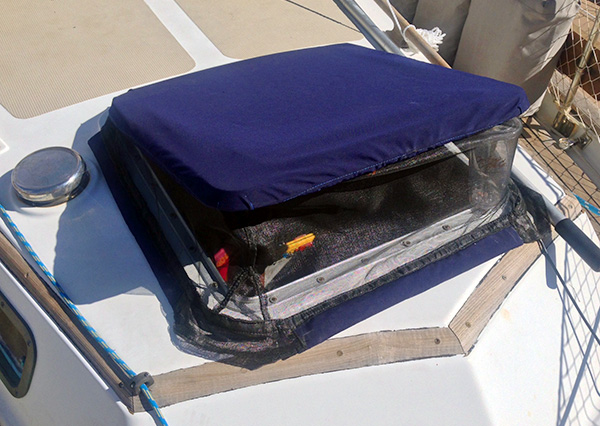
Sunbrella hatch covers help to keep the sun out (on our boat we've found the majority of the heat inside comes through the hatches and port-lights) while the integrated mosquito netting allows the hatches to be open and keep the bugs out.
But if you are like us and don't know what you need, that makes it hard to bring how much sunbrella? Mesh? Zippers? Snaps? Etc...?? We highly recommend getting your canvas work done in Ensenada by William before you head further south. It's much less expensive than in the US, and much better all-around experience than elsewhere in Mexico. To date, we have commissioned the following canvas work in Mexico:
Dinghy chaps -- canvas covers for your dinghy to protect the rubber/hypalon, which are also really nice to sit on rather than a piping-hot dinghy tube (and for non-hypalon dinghies they are a must for protecting against degradation of materials.) These can also have pockets sewn into them for things like sunglasses, VHF radio, etc. William makes great dinghy covers.
Kayak covers -- to protect our Advanced Elements inflatable kayaks from the sun. These fit on top or bottom, so if we have the kayaks stored upside down on deck, we cover the bottoms, if they are right-side-up, we cover the tops. William made these too.
Liferaft cover -- our liferaft is in a small nylon valise bag in the cockpit, and we wanted to give it extra protection from dust, dirt, saltwater, etc. This cover just slips over the top and easily comes off without any attachments in case of emergency.
Dodger/Bimini connector piece -- in Seattle we had the connector piece made out of sunbrella with an eisenglass window, which just turned our cockpit into a greenhouse in the Mexican sun. So we had a similar piece made out of plastic Breezway mesh that zips between the dodger and bimini. It lets in a bit of breeze and lets you see out, while keeping the stronger winds at bay. Apparently it will reduce the amount of rain getting into the cockpit, but we have yet to experience rain here.
Jerry Can Covers -- Remember those jerry cans we mentioned above? You'll want to have canvas covers to help protect them too. Covers not only help protect the non-UV-friendly plastic, they also help keep your fuel cooler. Anything plastic degrades quickly in the heat and sun.
Hatch Covers with Bug Screens -- If you have bug screens for your hatches you may just need hatch covers...or maybe you already have those as well. We didn't. So we had hatch covers made to help keep out the sun (even with the African Queen cover up, the sun can still shine through our 4 cabin-top hatches, really heating up the interior.) Our new hatch covers have built-in bug-screens to keep out mosquitoes, no-nos, bo-bos, etc. Word on the street is that Dengue Fever and Chikungunya Virus have reached the Sea of Cortez, so we'll do our best to keep mosquitos out. And also we bought a great mosquito net companionway cover online, which friends Jared & Karen recently brought down to us when they visited.
Dinghy Gasoline Tank, Hose & Bulb Cover -- We learned this one from our friend Roger. Keeping not only the gasoline tank, but also the gas hose and bulb covered and protected from the sun will help expand the life of these items as well. Left uncovered with the cap closed, the outboard gas tank will expand like a balloon, and even give improper fuel readings. We leave our cap slightly cracked open to relieve pressure, and the cover keeps the tank much cooler.
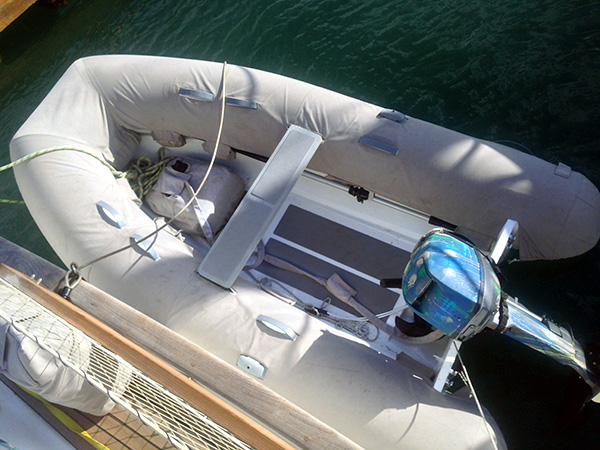
Dinghy chaps, gas tank cover, and gas hose/bulb cover (look along the dinghy floor) helping keep the sun off our dinghy "Aventuras". Hopefully the paint job on the "artboard" motor is a theft deterrent as well, but the artboard motor is always locked to Aventuras or to Due West. We also lock Aventuras to Due West with a bicycle cable. We have several lengths of cable we can hook together depending on where we need to lock her.
Dinghy Accoutrements
Our dinghy, Aventuras is our "car" and without her it could be hard to get to shore (ok, we have kayaks, but still...) so we take the utmost care of her. Besides covering her with dinghy chaps, this includes hoisting her out of the water every night and locking her to Due West, which not only helps prevent colonies of sea growth on the bottom, but also helps to ward off theft. Apparently when dinghies go missing it's usually the outboard they want not the dinghy itself, so the outboard is always locked to the dinghy or locked to the stern rail of Due West as well. Luckily it is pretty rare for dinghies to go Walk-about in Mexico, though it can happen and we'd rather be safe than sorry.
So how does one lift a 92lb dinghy with a 80lb outboard out of the water every night? We have a bridle-harness that clips to the D-rings inside of our dinghy that we then clip to a spinnaker halyard and grind her up. Or rather, Heidi grinds her up while Kirk keeps Aventuras pushed out away from the big boat for less friction. When our friend Teresa was visiting recently, she mentioned that on their boat they use a 8-1 "handy billy" block-and-tackle system that enables one person to hoist the dinghy up by themselves. Wow, great idea! We'll be getting two Harken 4-part blocks to make one of those soon. Thanks Teresa!
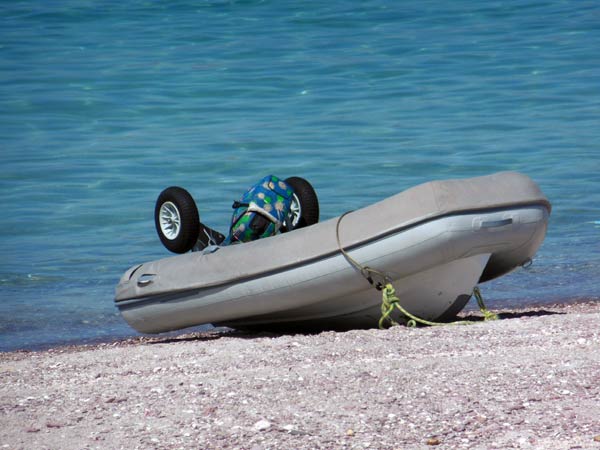
Dinghy wheels in the UP position.
Another dinghy accoutrement is our dinghy wheels. These attach to the transom of the dinghy and are deployed down in the water prior to landing on the beach. The wheels extend lower than the outboard so you can run the dinghy up on the beach without tilting the outboard up. They are most helpful on beaches with a lot of surf. We bought Danard Dinghy Wheels (which many of our long-term cruising friends have recommended) directly from Danard in Oxnard, CA when we stopped in there on our trip south. They will bring them right down to the boat for you. Great customer service!
A Word About Sailing, er-uh, Motoring
In the nine-months since we've left Seattle, we can count on one-hand the number of days we've actually had enough wind to sail all day. Like the Pacific Northwest in summer, the wind just isn't there during the day a lot of the time. However, the lack of wind in the day, can be made up for at night. We have motored much more than anticipated on this trip so far, partly because we're not willing to sit there bobbing around at 2-3 kts, or less, while the sails and rig slat and slam. This can cause unnecessary wear-and-tear to a boat. We try to maintain an average boat speed of at least 5kts, sometimes dipping down to 4kts, but will turn on our trusty Perkins M50 engine, "Michael P", if we get much below 5kts of boat speed for very long.
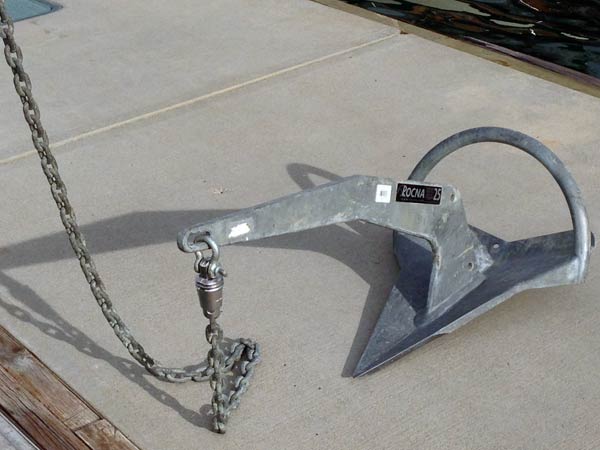
Our Rocna anchor with Mantus swivel, and 300' of 5/16" BBB all chain rode holds us secure at night. Still, there are times when we need to stand anchor watch to keep an eye out for other boats who may not be set as well as we are.
A Word About Anchoring
With local winds called Coromuels, Chubascos, and Elefantes which can howl up to 30-40kts at night in the Sea of Cortez, it's wise to have a GOOD anchor and ground tackle. We have a 25 kilo Rocna and 300' of 5/16" BBB chain rode. Plus a 40lb Bruce as our secondary anchor. Also note that anchoring skills of other cruisers varies widely, with some having very little anchoring experience before they head out cruising. We try to set our anchor in the sheltered side of the bay for the night-time winds, and also try to anchor with no one upwind of us who could potentially drag down on us in the night. This is not alway possible, however, and we've had to stand our fair share of anchor watches at night.
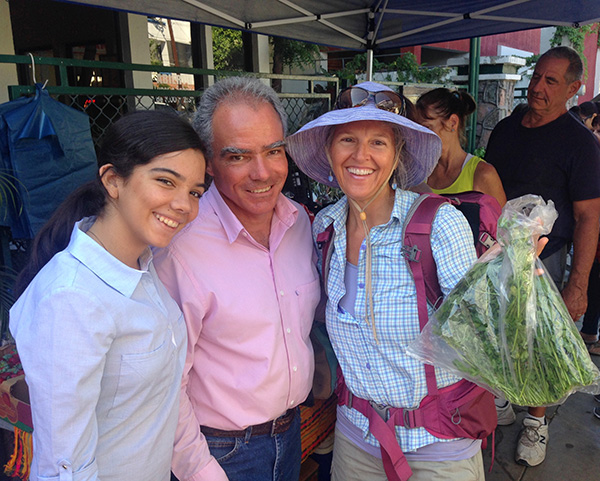
As often as possible we shop where the locals do. This not only saves money but we often get better produce, and we get to experience the local color too. We love buying produce from Victoria and her dad Martin at the La Paz Farmers Market every Tuesday and Saturday.
Grocery Shopping
On average we spend about $60 US a week on groceries. This includes shopping at farmers markets whenever possible, and buying lots of produce, fresh tortillas, and beans. We try to eat as "locally" as possible, and don't buy much processed/packaged food. We are also veg-aquarian (eat veggies and fish) and don't buy meat which can be expensive, but we do drink some alcohol (rum/tequila/beer/wine.) For comparison we have friends who spend about $120 US/week and they do eat meat but don't drink.
Heidi is gluten-free and we've been pleasantly surprised by the number of gluten-free products you can find here. However there are a few things that we've not found in Mexico: unsweetened cocoa powder (for baking), peanut butter (except sugar-filled Skippy-type), dried coconut flakes, and natural coconut milk (the kind without all of the BHA/BHT and other preservatives.) Luckily we have a Vitamix and love making our own nut butters, nut milks, and even hummus.
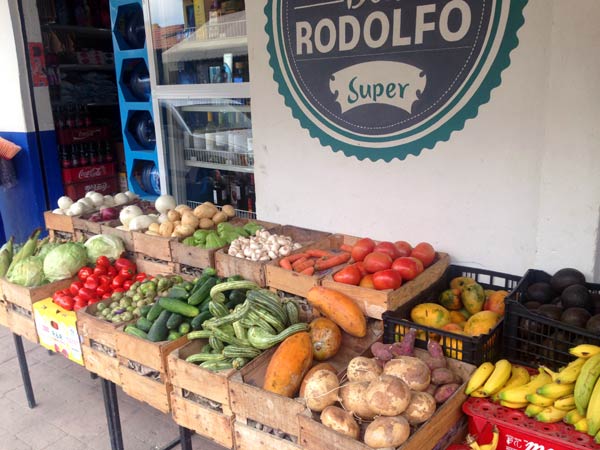
There is GREAT produce in Mexico, much of it organic, all of it colorful and fresh.
We aim to eat and live a life as organic, toxin-free, and sustainable as possible. In this regard, some things are easier in Mexico, some are harder. For example, before we left Seattle, we researched toxin-free cleaning products and discovered that they are virtually impossible to come by in Mexico. So we brought a year's supply of Seventh Generation laundry soap and dish soap with us, and make our other cleaning supplies out of white vinegar and essential oils. We do use Microdine (iodine based solution) to wash our produce. Debra on the sailboat Coastal Drifter has a great Facebook post on how to store fresh produce.
Thanks to Heidi's Neal's Yard Remedies Organic business, we also brought along a year's supply of organic, toxin-free, sustainable shampoo, conditioner, shower gel, deodorant, and even toothpaste. So we can't really speak to the brands of personal care products available here but from what we've seen in the grocery stores many US brands are available. We even brought a year's supply of healthy, dehydrated cat food from Honest Kitchen, for the Furbies.
Laundry and Other Services
Sometimes we do our own laundry at the laundromat, sometimes we send it out. If we send our laundry out for cleaning (50-pesos ($3US) a load compared to 20-pesos ($1.20US) to wash your own) we send along our own soap with instructions (in Spanish) to please use our soap and no fabric softener or dryer sheets. They are happy to comply (and save their own soap!)
Besides laundry services there are many other services that are very reasonably priced in Mexico. And though we are on a fixed budget, we try to use local services whenever possible to help support a local family and the local economy. We recently had all of the stainless steel polished on our boat for $24US. We also had the whole boat washed stem-to-stern for $24US. Each of these tasks would have taken us a whole day or more, and cost in the hundreds of dollars in the US. We were happy to help these young men make a day's wage, and they did excellent work.
Medical
As for medical costs and experiences, Mexico has been FANTASTIC! We've had a few occasions to visit doctors here in Mexico and have had nothing but positive experiences. Heidi got a mammogram for $30 that would have cost her $280 in the US. And the experience was the best mammogram experience she'd ever had (if there IS such a thing?! :-) Kirk saw a dermatologist, we both went to Physical Therapy, and acupuncture, and pretty much EVERY appointment has been an hour-long and cost $24-$30, no matter where you go, or what kind of doctor you see. And they fit you in right away. You call for an appointment and they ask "When do you want to come in? Today? Tomorrow?" Nice clean offices, terrific care, and usually at least one staff and/or doctor who speaks English, although we do our best to speak as much Spanish as possible. Our friend Boni just wrote a great blog post on medical care in Mexico.
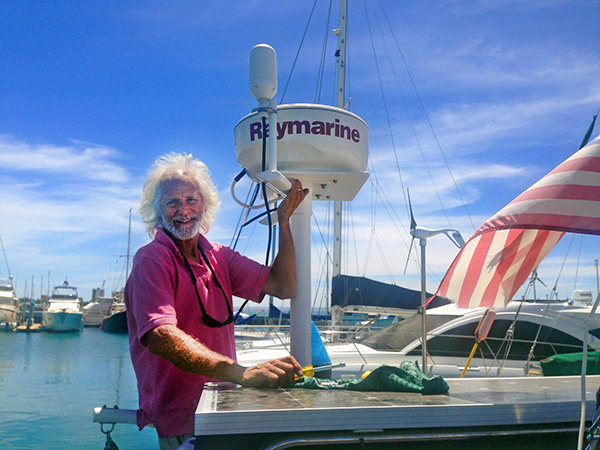
Captain Kirk hooking up the new antenna for the IridiumGo! Beam us UP Scotty...There is always some project to work on...it's a BOAT!
Internet
Since Heidi is still working part-time as we cruise (or attempting to!) blogging and selling organic products online, she needs to have semi-regular Internet connection. That has proven to be harder to find that we'd hoped. While it's always nice to be unplugged for a while, when you have client deadlines or product sales you need to advertise, let alone family health emergencies, or you are trying to get current weather forecasts, it's sometimes important to have Internet connection. We do have a wifi booster, but it's only as good as the Internet you're trying to boost...which sadly hasn't been very reliable.
We started our Internet adventures in Mexico by purchasing several "Banda Ancha" devices in Ensenada. These are USB sticks with a Mexican TelCel chip that allow for wifi anywhere you can get a TelCel signal, only available to Non-Mexican citizens. Not everywhere in MX has them available, but you can get them in Ensenada at the main TelCel in town. The USB device cost about $40US each, and we were originally told you could only use one per computer, so we bought three, one for each of two computers, and one chip for the iPad.
Turns out that was what we call a "gringo tax", miss information that cost us money. You only need one and can use it on any device, unless two of you need to be online at the same time, then you may need two. TelCel data for the chips currently costs $30US for 3 GIGs of data, which must be used within 30-days or it's lost. The problem is that 3 GIGs of data may only last for a week or two depending on what you are downloading or uploading, so data can start to get pretty pricy. If you go the Banda Ancha route check out this blog post Demystifying TelCel's Banda Ancha with step-by-step instructions to get it set up and working.
While most marinas have free wifi, and there are quite a few cafes and restaurants with free wifi too, so far it's never been at the speeds and reliability that we are used to in the US. And if you're in the middle of a software update and the Internet goes out...No Bueno! Because of this, Heidi has sought out Starbucks everywhere we've been, taking advantage of their free, reliable high-speed wifi. However, we are soon headed north into the Sea of Cortez and the land of "no-Starbucks" so this is not a permanent solution.
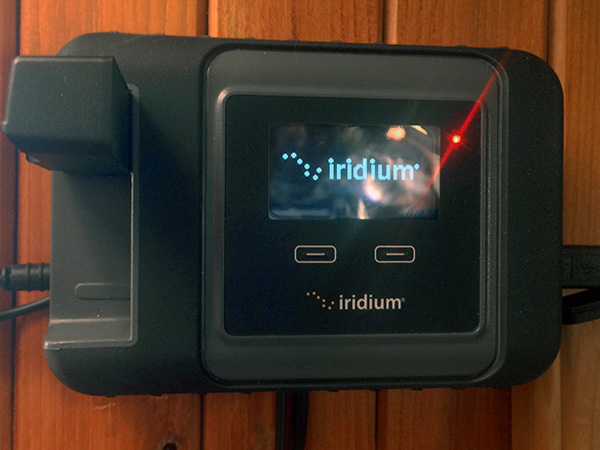
Internet access is few and far between in much of coastal Mexico and the Sea of Cortez. Our IridiumGo! satellite modem should allow for sending and receiving emails and texts via iPads plus making phone calls anywhere in the world using our iPhones for a very reasonable monthly fee. Stay tuned for how it actually works in practice.
We recently decided to spring for an IridiumGo! satellite modem that works with our existing smartphones, tablets, and computers to allow for satellite phone calls, texts, emails, (there are different data/call packages available depending on your needs) and equally as importantly, weather (WX) GRIB file downloads. We purchased our IridiumGo! package from PredictWind.com, and highly recommend going this route if you are going to buy an IridiumGo!
PredictWind has their own WX software that integrates nicely with the IridiumGo!, animating GRIB files and providing weather routing for you, for a minimal annual fee. PredictWind also has excellent customer service to help you get it all set up and working, where as Iridium sort of sends you off on your own. We have just finished installing this device, and are now able to send/receive text-only emails, text messages, download GRIB files for twice-daily weather forecasts, as well as make phone calls (2.5 hours of talk time included in our monthly plan) to stay in touch with family and friends for the next 5+ months in the Sea of Cortez. We'll update this info later in the season once we see how it works in practice, not just in theory!
Update November 2016: We LOVE LOVE LOVE our IridiumGO! with PredictWind weather account. Can't say enough good stuff about it. We've set up our gmail account (rules) to forward important emails to our Iridium address so Heidi doesn't miss any work emails. It also integrates nicely with SailBlogs as you can see on our tracking map. And the weather forecasting from PredictWind is fantastic. You can enter in the date you plan to leave and where you are going, and it gives you weather routing courses to follow. For the most part their WX forecasts have been pretty accurate. Best piece of connectivity equipment we have aboard.
The IridiumGo! also updates our location enroute so you can follow our adventures here.
Mail & Bills
People often ask what we do about mail and bills while we are cruising? Most bills can be put on auto-pay, and we have a fantastic mail forwarding/scanning service that helps with our mail. We use Dockside Solutions in Seattle, where they collect our mail for us, scan each envelope and send us a PDF, we decide what we want to have them open/scan/email, or hold onto. They will even deposit checks, pay bills, or forward mail, whatever you need, they can do. Dockside Solutions specializes in mail solutions for cruisers, RVers, fisherman, and other travelers, and we highly recommend their services if you need help with your mail. Tell Angie that Due West sent you.
Transportation
We walk, a LOT. Our pedometers say we average 3-4 miles a day walking around towns, provisioning, running errands, looking for a specific nut or bolt, etc, or just exploring. And most places we've been buses are great too, and very inexpensive. In La Cruz, a 45-minute bus ride to Puerto Vallarta cost only $2US. Heidi took the 3hr. Airporter bus from La Paz to Cabo for $30US. And local taxis around La Paz cost $3US from the grocery store to marina and $6US to go from one end of town to the other. But mostly we walk...
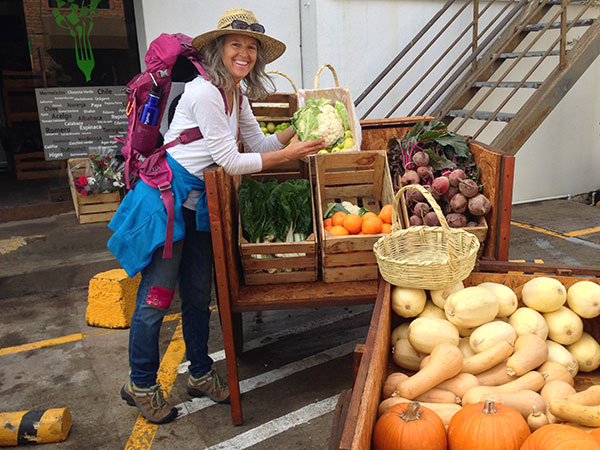
Did we mention that we walk...everywhere?! Our Osprey backpacks come in handy, always on our backs when we head out for errands around towns. We always pack our water bottles and a Kind Bar or trailmix for snacks too. (If you like Kind Bars stock up at home, while you can find them here, they cost twice as much.)
Exercise
While we've met some cruisers that feel they don't get enough exercise while cruising, we've found the opposite to be true. We are WAY more active cruising than we ever were at home. Did we mention that we walk, everywhere?! We are also usually carrying groceries, fuel jugs, laundry, boat parts, etc. in backpacks and/or in our hands. We love kayaking in our inflatable kayaks, which is a great upper-body workout. And we love to practice yoga, hike, swim, and snorkel, so we're always active one way or another.
When it comes to swimming we wear full-body lycra suits. These help to protect us from the potential of jelly stings, as well as from the sun. And so far, the water hasn't been all that warm, so they add a bit of warmth to our swims and snorkels too. The Sea of Cortez is rich with sea life from the largest blue whales down to the microscopic plankton soup. Kirk is considering a full-hood lycra suit for cleaning the bottom of the boat, as we've heard all the sea life you're scraping off can get in your ears, no thanks! Also, after each swim or snorkel we put in ear drops made of 50% white vinegar/50% rubbing alcohol. This helps to kill any bacteria that made its way into your ears, and prevent ear infections.
Whew! We know that's a lot of info to digest, so bookmark this page to come back to it whenever you need to. Please leave comments to let us know your cruising tips and tricks as well.
Happy Sailing! Best of luck casting off from shore...and don't get too overwhelmed by the stress getting ready to leave...every cruiser has moments of thinking "we'll never get this all done, we won't be able to leave!", but they all prove themselves wrong, and enough gets done that you can and will leave! Just look at us, we're still installing our watermaker 9-months later! :-)
Current plans are to head north into the Sea of Cortez next week and will be trying out our new IridiumGo! to see if we can post blogs and send emails along the way, so stay tuned on that front!
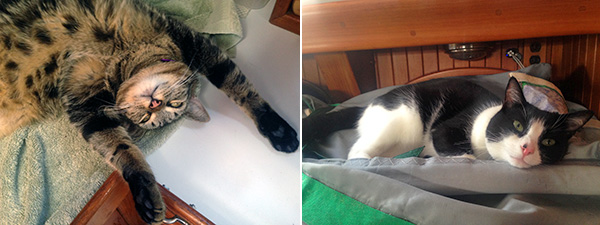
Tosh and Tikka are adjusting to the heat and still loving being Gatos del Mar!
While this LONG blog post is mostly aimed at other sailors getting ready to go cruising, hopefully it will be of general interest to our friends and family as well. For cruisers setting sail from the US and Canada this summer/fall we wanted to share some things we've learned along the way--things we wish we'd known before we left Seattle, or at least before we left the US.

We'll be modifying our Pacific Northwest African Queen sunshade design to include mesh side panels to help shade the cockpit and house. We've also picked up some Coolaroo sun-shades at Costco to cover the bow of Due West or hang from halyards for moveable sun protection.
For the most part we are LOVING the cruising lifestyle. There are those random days when everything goes sideways, but then you have those days at home too, and it's not nearly as warm there! However, cruising isn't for everyone. We recently met a couple who were quitting after two years because they were bored...Bored??? We can't figure out how they had time to be bored. Another couple, missing their kids and grand kids, is heading home after one year of cruising. Our advice is to have no expectations, go with the flow, and enjoy life to the fullest!
If you're new to our blog, we have owned our Passport 40 for 24 years, raced her to Hawaii (Vic-Maui '96), cruised her throughout the Pacific Northwest, plus we've chartered several times in the Caribbean. We are new to full-time cruising in Mexico and beyond and by no means have all the answers. This is just our experiences over the past few months. Hopefully these tips and tricks will help others as they prepare to cruise in warmer climates.

Cruising Guide Books
We love the Shawn Breeding & Heather Bansmer books, Sea of Cortez and Pacific Mexico. Their photos and descriptions are fantastic, and their waypoints are spot-on. We also have the new Charlie's Chart Mexico book, totally updated and revamped by Holly Scott, it's even perfect-bound, not comb bound anymore. And for charts we just got the Gary Cunningham Charts which are purported to be the most accurate paper charts of Pacific Coast Baja and the Sea of Cortez. Not like your electronic charts (Navionics!) which may have you 1-2 miles IN-shore in some places!?

While shopping at the organic farmer's market isn't necessarily the cheapest, it is the healthiest. Here we are buying all natural, essential oil based bug repellent to spray on our bug screens. We try to pay cash for everything which helps us with budgeting.
Budgeting
Potential cruisers alway want to know: "How much does it cost to go cruising?" The truth is you can cruise on ANY budget, but some items are non-negotiable, like paying for visas to visit new countries, exit fees when you leave, etc. Many countries and/or marinas now also require you to have boat insurance. There are people cruising on more and on less than we are. We are cruising on a budget of about $2,000 US/month. We don't eat out a lot (we actually think our own home-cooked food tastes better! :-) but we've stayed in way more marinas than we planned to, which can add up.
Staying in marinas allowed us to use the free wifi, plus dock-space and electricity to finish up a few projects that were non-critical for our US cruising, but would be much needed in Mexico and beyond. (When we left Seattle we still had several incomplete projects including water maker, inverter, two more solar panels, cockpit shower, etc., which we'd planned to work on and install underway.) Another plus of staying in marinas has been the close proximity of towns, enabling us to explore and see more of the local culture.

It's nice to have dock space and electricity for working on larger boat projects, but we're looking very forward to spending more time on the hook and not in so many marinas which are a budget-killer!
Though we tried our best to plan ahead for these projects before leaving home, as is true with any boat project you tackle at "home" or away, things can morph, balloon, and need more or different parts and time than originally anticipated. Because of this, we've exceeded our monthly budget almost every month since we left Seattle.
That being said, as we prepare to head north into the Sea of Cortez for the next 6 months, most of our major installations will be done, and there will be very little for us to spend any money on other than food (cheap!) and some fuel depending on how much wind we have for sailing, so by year-end we should still be within our annual budget. Of course there are always maintenance and repairs to be done which brings us to spare parts...

We try to have as many spares as possible, including things like tools. Tikka (and Tosh) are ever helpful when it comes to tools and parts and boat projects! ;-)
Spare Parts
Before we left Seattle we tried to anticipate every possible spare part we might need. We'd heard from friends cruising in Mexico and beyond that it's virtually impossible to get spare parts shipped to you. So much so that many people will buy a plane ticket home, buy everything they need, and bring it back in their luggage, as this can be cheaper as well as a more reliable way to ensure you are getting the exact parts you need. Or you can have friends and family bring you parts when they visit.
While there are some marine chandleries here and there in Mexico (at least three in La Paz, and a couple in La Cruz that we know of), their prices can be two-to-three times that of the US, and they often don't stock what you need. Factory reps for electronics also vary widely so it's prudent to ask around to see who is recommended.
Of course it's impossible to second guess everything you'll need! But we did our best, and stocked up on lots of things like pumps, pump rebuild kits, head rebuild kits, nuts, bolts, screws, paints, etc. And still there are things we need to get when we go home to visit: spare alternator, spare starter, two 4-part blocks (to make our dinghy hoist system, see below), etc.
Occasionally you get lucky! Like just the other day when La Paz Cruiser's Supply had the exact part that Kirk needed for the watermaker installation. And then when Kirk was looking for a machine shop to drill and tap a hole, we met another cruiser with a full machine-shop onboard who was happy to do it for us! Thanks Michael & Didi!
As for trying to have items shipped to you, if they make it past customs without being "lost", there can be a hefty import tax. We've recently heard that the old method of having your TIP (Temporary Import Permit which you will pay for and receive at your first port of entry into Mexico) be your golden-ticket to importing anything for your boat... no longer works that way. But no one really knows quite how it's supposed to work now... and by the time you read this it may have changed again. We have had several friends bring items to us, and we will be going home for a visit and stocking up on things we can't get here as well, like good jerry cans!

Our canvas jerry can covers help protect the plastic from the sun, and the fuel from the heat. We have 2" x 6" lashing boards on each side of the foredeck to lash our jerry cans to while under way. We also had the jerry can covers made with velcro handle covers, so that the whole can can be covered, or we can uncover the handle for carrying them with covers on.
Jerry Cans
In case you're not familiar with jerry cans, they are 20-liter (~5-gallon) plastic storage cans for extra diesel, gasoline or water, (based on a design from WWII and Korea.) We bought some in San Diego before we left the states. Jerry cans can be very helpful if you're traveling to more remote areas where fuel is harder to come by. We originally purchased 4 for diesel (yellow cans), 1 for dinghy gasoline (red), and 1 for water (blue.) And we already had a small 2-gallon red gas can for our Honda 2000i generator (see below.)
We soon realized where we'll be going, we wanted to have more diesel capacity than the jerry cans we'd purchased in the US and wanted to buy two more yellow cans for diesel. Unfortunately they are very hard to come by in Mexico, and if you can find them they will cost twice what they do in the US, making them cost prohibitive to our budget. We did find some cheap Mexican knock-offs, which likely won't last as long as the ones you can find at home but that's what we have for now.
Figure out your extra fuel (or water) needs before you leave home, and stock up accordingly. This will vary depending on your own tankage volume and where you plan to cruise, if you have a watermaker, or how long you are willing to sit in little to no-wind before you get somewhere. We carry a generous 120 gallons of diesel in our tanks, so with the extra jerry cans full we now have fuel capacity of 150 gallons, or about 700-1,000 nautical mile cruising range depending on wind assist.
Honda 2000i Generator
Our veteran cruising friends had recommended we get a small, portable Honda 2000i generator before leaving the US. We actually bought ours a few years ago in Oregon to save on sales tax, and used it many times cruising in the San Juans and Gulf Islands. So why would you need a generator? Because we don't have our inverter installed (yet) we mostly use our 2000i generator to charge our laptop computers (Apple has yet to come up with a 12-volt car charger!?) and for running power tools, the vacuum, our Vitamix, etc. when we're on the hook.
The Honda 2000i is very quite and very fuel efficient, burning about one gallon for 6-8 hours of use. You can even charge the house batteries (rather than run the boat engine) and/or jump the starting battery from it if need be. For safety, due to the potential of fumes, it lives on deck and is always locked to the boat when not in use.
Amazingly, we even purchased an in-hatch air conditioner unit (from another cruiser) to help cool the boat down for our cats when it gets into the 100°s this summer in the Sea of Cortez. This A/C unit will run on the Honda 2000i as well. Our generator has come in very handy on more than one occasion, and we're glad we have it. Plus we found a Honda 2000i canvas cover online to help protect it from the sun.
Canvas Covers
Speaking of Sun protection...the sun is HOT in Mexico, very hot! For those of you who know Heidi and her penchant for wearing fleece and down jackets (and Kirk's motto of "A warm Heidi is a Happy Heidi"!) you may be surprised to hear that Heidi has met her match. She's actually proclaimed being TOO HOT!?! on several occasions...and summer isn't even here yet! Many days the inside of the cabin is 85-90°. But we digress... the SUN is HOT. And beats down on your boat and everything on it relentlessly. Because of this you need canvas covers for EVERYTHING.
When we left Seattle we had a large "African Queen" awning that we used for rain/snow protection (see top photo.) We're now experimenting with modifying that to include mesh side panels, and a front section to shade the bow. But are wishing we'd had this done sooner, for more effective sun protection now. In the meantime we bought some 13' Coolaroo awning triangles from Costco that are helping us make do.

William "Bill" Solares at Ensenada Custom Upholstery, in Ensenada, MX is the best canvas worker we've encountered. Our advice is to stop in Ensenada on your way down (Cruiseport Marina) and have all your canvas work done by Bill there. Phone: +52 646 198 1678. We've actually contemplated taking the bus back up for more canvas work!
We knew from our veteran cruising friends that we wanted to have dinghy chaps before we got to warmer weather, so we had those made by William Solares at Ensenada Custom Upholstery, [phone: +52 646 198 1678], in Ensenada. William used to live in the US and has great English in case your Spanish isn't quite up to snuff. He was fantastic to work with, has excellent craftsmanship, and at very reasonable prices...now that we're in La Paz we are trying to get more canvas work done, and after dealing with three different no-shows, and another guy who's been a bit flakey, we wished we'd had William do everything. Unfortunately we didn't know what all we needed when we were in Ensenada (and we probably still don't!) William was in close-proximity to San Diego and could get everything needed in the way of supplies. Further south in Mexico, we've been advised that it's best to supply all of your own materials.

Sunbrella hatch covers help to keep the sun out (on our boat we've found the majority of the heat inside comes through the hatches and port-lights) while the integrated mosquito netting allows the hatches to be open and keep the bugs out.
But if you are like us and don't know what you need, that makes it hard to bring how much sunbrella? Mesh? Zippers? Snaps? Etc...?? We highly recommend getting your canvas work done in Ensenada by William before you head further south. It's much less expensive than in the US, and much better all-around experience than elsewhere in Mexico. To date, we have commissioned the following canvas work in Mexico:
Dinghy chaps -- canvas covers for your dinghy to protect the rubber/hypalon, which are also really nice to sit on rather than a piping-hot dinghy tube (and for non-hypalon dinghies they are a must for protecting against degradation of materials.) These can also have pockets sewn into them for things like sunglasses, VHF radio, etc. William makes great dinghy covers.
Kayak covers -- to protect our Advanced Elements inflatable kayaks from the sun. These fit on top or bottom, so if we have the kayaks stored upside down on deck, we cover the bottoms, if they are right-side-up, we cover the tops. William made these too.
Liferaft cover -- our liferaft is in a small nylon valise bag in the cockpit, and we wanted to give it extra protection from dust, dirt, saltwater, etc. This cover just slips over the top and easily comes off without any attachments in case of emergency.
Dodger/Bimini connector piece -- in Seattle we had the connector piece made out of sunbrella with an eisenglass window, which just turned our cockpit into a greenhouse in the Mexican sun. So we had a similar piece made out of plastic Breezway mesh that zips between the dodger and bimini. It lets in a bit of breeze and lets you see out, while keeping the stronger winds at bay. Apparently it will reduce the amount of rain getting into the cockpit, but we have yet to experience rain here.
Jerry Can Covers -- Remember those jerry cans we mentioned above? You'll want to have canvas covers to help protect them too. Covers not only help protect the non-UV-friendly plastic, they also help keep your fuel cooler. Anything plastic degrades quickly in the heat and sun.
Hatch Covers with Bug Screens -- If you have bug screens for your hatches you may just need hatch covers...or maybe you already have those as well. We didn't. So we had hatch covers made to help keep out the sun (even with the African Queen cover up, the sun can still shine through our 4 cabin-top hatches, really heating up the interior.) Our new hatch covers have built-in bug-screens to keep out mosquitoes, no-nos, bo-bos, etc. Word on the street is that Dengue Fever and Chikungunya Virus have reached the Sea of Cortez, so we'll do our best to keep mosquitos out. And also we bought a great mosquito net companionway cover online, which friends Jared & Karen recently brought down to us when they visited.
Dinghy Gasoline Tank, Hose & Bulb Cover -- We learned this one from our friend Roger. Keeping not only the gasoline tank, but also the gas hose and bulb covered and protected from the sun will help expand the life of these items as well. Left uncovered with the cap closed, the outboard gas tank will expand like a balloon, and even give improper fuel readings. We leave our cap slightly cracked open to relieve pressure, and the cover keeps the tank much cooler.

Dinghy chaps, gas tank cover, and gas hose/bulb cover (look along the dinghy floor) helping keep the sun off our dinghy "Aventuras". Hopefully the paint job on the "artboard" motor is a theft deterrent as well, but the artboard motor is always locked to Aventuras or to Due West. We also lock Aventuras to Due West with a bicycle cable. We have several lengths of cable we can hook together depending on where we need to lock her.
Dinghy Accoutrements
Our dinghy, Aventuras is our "car" and without her it could be hard to get to shore (ok, we have kayaks, but still...) so we take the utmost care of her. Besides covering her with dinghy chaps, this includes hoisting her out of the water every night and locking her to Due West, which not only helps prevent colonies of sea growth on the bottom, but also helps to ward off theft. Apparently when dinghies go missing it's usually the outboard they want not the dinghy itself, so the outboard is always locked to the dinghy or locked to the stern rail of Due West as well. Luckily it is pretty rare for dinghies to go Walk-about in Mexico, though it can happen and we'd rather be safe than sorry.
So how does one lift a 92lb dinghy with a 80lb outboard out of the water every night? We have a bridle-harness that clips to the D-rings inside of our dinghy that we then clip to a spinnaker halyard and grind her up. Or rather, Heidi grinds her up while Kirk keeps Aventuras pushed out away from the big boat for less friction. When our friend Teresa was visiting recently, she mentioned that on their boat they use a 8-1 "handy billy" block-and-tackle system that enables one person to hoist the dinghy up by themselves. Wow, great idea! We'll be getting two Harken 4-part blocks to make one of those soon. Thanks Teresa!

Dinghy wheels in the UP position.
Another dinghy accoutrement is our dinghy wheels. These attach to the transom of the dinghy and are deployed down in the water prior to landing on the beach. The wheels extend lower than the outboard so you can run the dinghy up on the beach without tilting the outboard up. They are most helpful on beaches with a lot of surf. We bought Danard Dinghy Wheels (which many of our long-term cruising friends have recommended) directly from Danard in Oxnard, CA when we stopped in there on our trip south. They will bring them right down to the boat for you. Great customer service!
A Word About Sailing, er-uh, Motoring
In the nine-months since we've left Seattle, we can count on one-hand the number of days we've actually had enough wind to sail all day. Like the Pacific Northwest in summer, the wind just isn't there during the day a lot of the time. However, the lack of wind in the day, can be made up for at night. We have motored much more than anticipated on this trip so far, partly because we're not willing to sit there bobbing around at 2-3 kts, or less, while the sails and rig slat and slam. This can cause unnecessary wear-and-tear to a boat. We try to maintain an average boat speed of at least 5kts, sometimes dipping down to 4kts, but will turn on our trusty Perkins M50 engine, "Michael P", if we get much below 5kts of boat speed for very long.

Our Rocna anchor with Mantus swivel, and 300' of 5/16" BBB all chain rode holds us secure at night. Still, there are times when we need to stand anchor watch to keep an eye out for other boats who may not be set as well as we are.
A Word About Anchoring
With local winds called Coromuels, Chubascos, and Elefantes which can howl up to 30-40kts at night in the Sea of Cortez, it's wise to have a GOOD anchor and ground tackle. We have a 25 kilo Rocna and 300' of 5/16" BBB chain rode. Plus a 40lb Bruce as our secondary anchor. Also note that anchoring skills of other cruisers varies widely, with some having very little anchoring experience before they head out cruising. We try to set our anchor in the sheltered side of the bay for the night-time winds, and also try to anchor with no one upwind of us who could potentially drag down on us in the night. This is not alway possible, however, and we've had to stand our fair share of anchor watches at night.

As often as possible we shop where the locals do. This not only saves money but we often get better produce, and we get to experience the local color too. We love buying produce from Victoria and her dad Martin at the La Paz Farmers Market every Tuesday and Saturday.
Grocery Shopping
On average we spend about $60 US a week on groceries. This includes shopping at farmers markets whenever possible, and buying lots of produce, fresh tortillas, and beans. We try to eat as "locally" as possible, and don't buy much processed/packaged food. We are also veg-aquarian (eat veggies and fish) and don't buy meat which can be expensive, but we do drink some alcohol (rum/tequila/beer/wine.) For comparison we have friends who spend about $120 US/week and they do eat meat but don't drink.
Heidi is gluten-free and we've been pleasantly surprised by the number of gluten-free products you can find here. However there are a few things that we've not found in Mexico: unsweetened cocoa powder (for baking), peanut butter (except sugar-filled Skippy-type), dried coconut flakes, and natural coconut milk (the kind without all of the BHA/BHT and other preservatives.) Luckily we have a Vitamix and love making our own nut butters, nut milks, and even hummus.

There is GREAT produce in Mexico, much of it organic, all of it colorful and fresh.
We aim to eat and live a life as organic, toxin-free, and sustainable as possible. In this regard, some things are easier in Mexico, some are harder. For example, before we left Seattle, we researched toxin-free cleaning products and discovered that they are virtually impossible to come by in Mexico. So we brought a year's supply of Seventh Generation laundry soap and dish soap with us, and make our other cleaning supplies out of white vinegar and essential oils. We do use Microdine (iodine based solution) to wash our produce. Debra on the sailboat Coastal Drifter has a great Facebook post on how to store fresh produce.
Thanks to Heidi's Neal's Yard Remedies Organic business, we also brought along a year's supply of organic, toxin-free, sustainable shampoo, conditioner, shower gel, deodorant, and even toothpaste. So we can't really speak to the brands of personal care products available here but from what we've seen in the grocery stores many US brands are available. We even brought a year's supply of healthy, dehydrated cat food from Honest Kitchen, for the Furbies.
Laundry and Other Services
Sometimes we do our own laundry at the laundromat, sometimes we send it out. If we send our laundry out for cleaning (50-pesos ($3US) a load compared to 20-pesos ($1.20US) to wash your own) we send along our own soap with instructions (in Spanish) to please use our soap and no fabric softener or dryer sheets. They are happy to comply (and save their own soap!)
Besides laundry services there are many other services that are very reasonably priced in Mexico. And though we are on a fixed budget, we try to use local services whenever possible to help support a local family and the local economy. We recently had all of the stainless steel polished on our boat for $24US. We also had the whole boat washed stem-to-stern for $24US. Each of these tasks would have taken us a whole day or more, and cost in the hundreds of dollars in the US. We were happy to help these young men make a day's wage, and they did excellent work.
Medical
As for medical costs and experiences, Mexico has been FANTASTIC! We've had a few occasions to visit doctors here in Mexico and have had nothing but positive experiences. Heidi got a mammogram for $30 that would have cost her $280 in the US. And the experience was the best mammogram experience she'd ever had (if there IS such a thing?! :-) Kirk saw a dermatologist, we both went to Physical Therapy, and acupuncture, and pretty much EVERY appointment has been an hour-long and cost $24-$30, no matter where you go, or what kind of doctor you see. And they fit you in right away. You call for an appointment and they ask "When do you want to come in? Today? Tomorrow?" Nice clean offices, terrific care, and usually at least one staff and/or doctor who speaks English, although we do our best to speak as much Spanish as possible. Our friend Boni just wrote a great blog post on medical care in Mexico.

Captain Kirk hooking up the new antenna for the IridiumGo! Beam us UP Scotty...There is always some project to work on...it's a BOAT!
Internet
Since Heidi is still working part-time as we cruise (or attempting to!) blogging and selling organic products online, she needs to have semi-regular Internet connection. That has proven to be harder to find that we'd hoped. While it's always nice to be unplugged for a while, when you have client deadlines or product sales you need to advertise, let alone family health emergencies, or you are trying to get current weather forecasts, it's sometimes important to have Internet connection. We do have a wifi booster, but it's only as good as the Internet you're trying to boost...which sadly hasn't been very reliable.
We started our Internet adventures in Mexico by purchasing several "Banda Ancha" devices in Ensenada. These are USB sticks with a Mexican TelCel chip that allow for wifi anywhere you can get a TelCel signal, only available to Non-Mexican citizens. Not everywhere in MX has them available, but you can get them in Ensenada at the main TelCel in town. The USB device cost about $40US each, and we were originally told you could only use one per computer, so we bought three, one for each of two computers, and one chip for the iPad.
Turns out that was what we call a "gringo tax", miss information that cost us money. You only need one and can use it on any device, unless two of you need to be online at the same time, then you may need two. TelCel data for the chips currently costs $30US for 3 GIGs of data, which must be used within 30-days or it's lost. The problem is that 3 GIGs of data may only last for a week or two depending on what you are downloading or uploading, so data can start to get pretty pricy. If you go the Banda Ancha route check out this blog post Demystifying TelCel's Banda Ancha with step-by-step instructions to get it set up and working.
While most marinas have free wifi, and there are quite a few cafes and restaurants with free wifi too, so far it's never been at the speeds and reliability that we are used to in the US. And if you're in the middle of a software update and the Internet goes out...No Bueno! Because of this, Heidi has sought out Starbucks everywhere we've been, taking advantage of their free, reliable high-speed wifi. However, we are soon headed north into the Sea of Cortez and the land of "no-Starbucks" so this is not a permanent solution.

Internet access is few and far between in much of coastal Mexico and the Sea of Cortez. Our IridiumGo! satellite modem should allow for sending and receiving emails and texts via iPads plus making phone calls anywhere in the world using our iPhones for a very reasonable monthly fee. Stay tuned for how it actually works in practice.
We recently decided to spring for an IridiumGo! satellite modem that works with our existing smartphones, tablets, and computers to allow for satellite phone calls, texts, emails, (there are different data/call packages available depending on your needs) and equally as importantly, weather (WX) GRIB file downloads. We purchased our IridiumGo! package from PredictWind.com, and highly recommend going this route if you are going to buy an IridiumGo!
PredictWind has their own WX software that integrates nicely with the IridiumGo!, animating GRIB files and providing weather routing for you, for a minimal annual fee. PredictWind also has excellent customer service to help you get it all set up and working, where as Iridium sort of sends you off on your own. We have just finished installing this device, and are now able to send/receive text-only emails, text messages, download GRIB files for twice-daily weather forecasts, as well as make phone calls (2.5 hours of talk time included in our monthly plan) to stay in touch with family and friends for the next 5+ months in the Sea of Cortez. We'll update this info later in the season once we see how it works in practice, not just in theory!
Update November 2016: We LOVE LOVE LOVE our IridiumGO! with PredictWind weather account. Can't say enough good stuff about it. We've set up our gmail account (rules) to forward important emails to our Iridium address so Heidi doesn't miss any work emails. It also integrates nicely with SailBlogs as you can see on our tracking map. And the weather forecasting from PredictWind is fantastic. You can enter in the date you plan to leave and where you are going, and it gives you weather routing courses to follow. For the most part their WX forecasts have been pretty accurate. Best piece of connectivity equipment we have aboard.
The IridiumGo! also updates our location enroute so you can follow our adventures here.
Mail & Bills
People often ask what we do about mail and bills while we are cruising? Most bills can be put on auto-pay, and we have a fantastic mail forwarding/scanning service that helps with our mail. We use Dockside Solutions in Seattle, where they collect our mail for us, scan each envelope and send us a PDF, we decide what we want to have them open/scan/email, or hold onto. They will even deposit checks, pay bills, or forward mail, whatever you need, they can do. Dockside Solutions specializes in mail solutions for cruisers, RVers, fisherman, and other travelers, and we highly recommend their services if you need help with your mail. Tell Angie that Due West sent you.
Transportation
We walk, a LOT. Our pedometers say we average 3-4 miles a day walking around towns, provisioning, running errands, looking for a specific nut or bolt, etc, or just exploring. And most places we've been buses are great too, and very inexpensive. In La Cruz, a 45-minute bus ride to Puerto Vallarta cost only $2US. Heidi took the 3hr. Airporter bus from La Paz to Cabo for $30US. And local taxis around La Paz cost $3US from the grocery store to marina and $6US to go from one end of town to the other. But mostly we walk...

Did we mention that we walk...everywhere?! Our Osprey backpacks come in handy, always on our backs when we head out for errands around towns. We always pack our water bottles and a Kind Bar or trailmix for snacks too. (If you like Kind Bars stock up at home, while you can find them here, they cost twice as much.)
Exercise
While we've met some cruisers that feel they don't get enough exercise while cruising, we've found the opposite to be true. We are WAY more active cruising than we ever were at home. Did we mention that we walk, everywhere?! We are also usually carrying groceries, fuel jugs, laundry, boat parts, etc. in backpacks and/or in our hands. We love kayaking in our inflatable kayaks, which is a great upper-body workout. And we love to practice yoga, hike, swim, and snorkel, so we're always active one way or another.
When it comes to swimming we wear full-body lycra suits. These help to protect us from the potential of jelly stings, as well as from the sun. And so far, the water hasn't been all that warm, so they add a bit of warmth to our swims and snorkels too. The Sea of Cortez is rich with sea life from the largest blue whales down to the microscopic plankton soup. Kirk is considering a full-hood lycra suit for cleaning the bottom of the boat, as we've heard all the sea life you're scraping off can get in your ears, no thanks! Also, after each swim or snorkel we put in ear drops made of 50% white vinegar/50% rubbing alcohol. This helps to kill any bacteria that made its way into your ears, and prevent ear infections.
Whew! We know that's a lot of info to digest, so bookmark this page to come back to it whenever you need to. Please leave comments to let us know your cruising tips and tricks as well.
Happy Sailing! Best of luck casting off from shore...and don't get too overwhelmed by the stress getting ready to leave...every cruiser has moments of thinking "we'll never get this all done, we won't be able to leave!", but they all prove themselves wrong, and enough gets done that you can and will leave! Just look at us, we're still installing our watermaker 9-months later! :-)
Current plans are to head north into the Sea of Cortez next week and will be trying out our new IridiumGo! to see if we can post blogs and send emails along the way, so stay tuned on that front!

Tosh and Tikka are adjusting to the heat and still loving being Gatos del Mar!
Comments
| Vessel Name: | Due West |
| Vessel Make/Model: | Passport 40 |
| Hailing Port: | Seattle, WA |
| Crew: | Captain Kirk & Heidi Hackler + Tosh & Tikka |
| About: | |
| Extra: | See pix of our boat here: Due West Interior Photos and in the Photo Gallery. |
| Home Page: | http://svduewest.com |
Due West's Photos - Main
s/v Due West & Crew

Who: Captain Kirk & Heidi Hackler + Tosh & Tikka
Port: Seattle, WA
